
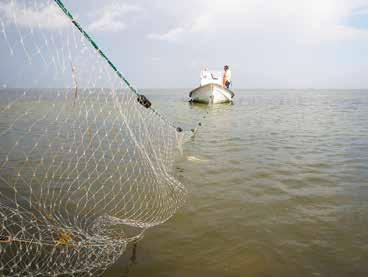
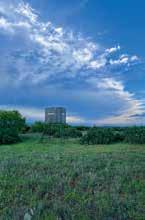




By Nate Skinner For Lone Star outdoor newS
The Texas Parks and Wildlife Department’s gill net sampling program continues to remain suspended due to a
federal investigation. The impacts of this threaten to dismantle the longest running fishery independent monitoring program of its kind in the country. An interruption in the program could lead to a lack of sufficient and current data necessary to monitor the status of our state’s coastal fisheries.
According to Deputy Director of the TPWD Coastal Fisheries Division Dakus Geeslin, all TPWD gill net monitoring and survey efforts ceased on May 23, 2024. This was in
By Nate Skinner For Lone Star outdoor newS
Most archery hunters experienced typical early season activity during the opening weekend of archery season. Mild to warm temperatures restricted most deer movement to the early morning, late evening, and overnight hours. Plenty of green vegetation and acorns hitting the ground in many areas made for minimal traffic around feeders. However, some hunters were lucky enough to find themselves at the right place at the right time and a few harvested mature bucks.
Cody Johnston hunted on a property he leases in Schleicher County during the opening weekend of archery season and said the deer movement around his feeders was pretty slow.
“The deer I did see didn’t spend much time eating corn,” Johnston said. “They seemed to be more focused on acorns

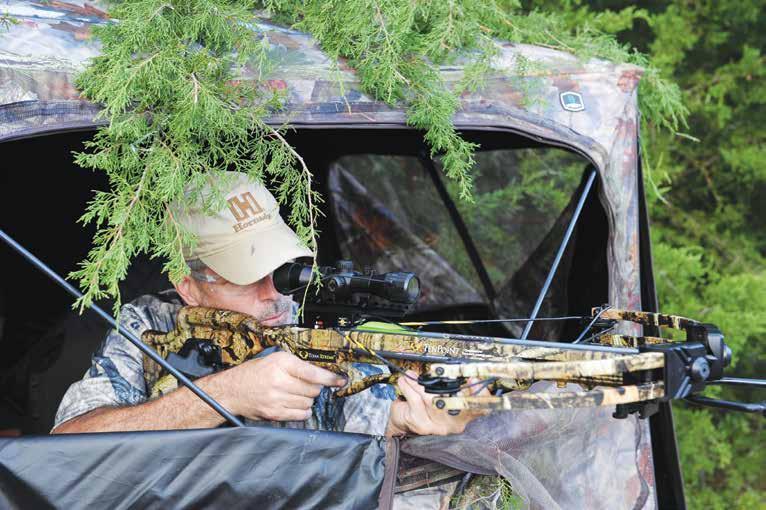
By Cory Byrnes For Lone Star outdoor newS
On Lake Texoma and Lake Ray Roberts, the white bass fishing has been hot.
“We have been catching more white bass than normal this year,” said Justin Wilson with UCatchem Guide Service.
The morning has been the best bite for white bass. He and his clients have been catching up shallow until late in the morning.
“Generally, I have enough time to catch
my striper limit and then go catch my white bass,” Wilson said. “It is usually over by mid-morning.”
The most productive baits have been small swimbaits in bright colors.
“You can pretty much throw anything shiny in them and catch them,” Wilson said. “They are just moving around fast. You will have to keep moving; they will pop up in front of you, and the next thing you know, they will be 100 yards away.
“There is a lot of bait in the lake right now.”
But different water bodies present different challenges when chasing the schooling, fast-moving fish.





By Cory Byrnes
For Lone Star outdoor newS
West Texas is quickly gaining a reputation nationally as an up and coming place to hunt big bull elk.
Still listed as an exotic species by Texas Parks and Wildlife Department, there are no public hunting opportunities for elk in the state currently. However, this season has gotten off to a great start for many hunters pursuing big Texas elk on several private ranches in
the Trans-Pecos region.
“It’s been an excellent year so far. We had some great rains, which means good antler growth,” said
Mike McKinney with West Texas Hunt Organization when speaking about the Fort Stockton and Sanderson areas. He reports the numbers of elk on the properties he hunts have been really good.
“Their ranges are definitely expanding from where they were before,” McKinney said. “Ranches I aoudad hunt 50 to 60 miles away are starting to have elk on them.”
McKinney and his clients target elk during the September rut.
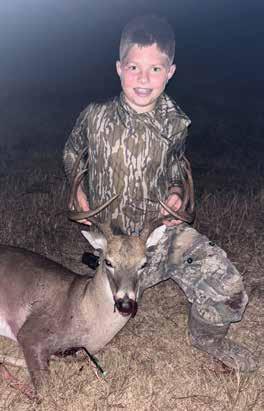
Because elk are considered exotic, you can rifle hunt them all year. While the terrain is not as rugged as a western elk hunt, hunters should still be ready to pack an animal out after their hunt.
“They are very high-success-rate hunts,” McKinney said.
In the Trans-Pacos area, hunting has been outstanding so far.
“It’s been good. We are a little over halfway through our fall cycle with our elk hunts. We have had 19 hunters in so far and it’s gone good. We are 19 for 19,” said Greg Simons, owner of Wildlife Systems Inc.
Range conditions had been particularly dry this year heading into summer.
“It wasn’t until June that we started catching some good rains out here,” Simons said. “It’s been the strongest season we have had ever. There certainly are some bulls out there that were compromised because of forage conditions. Despite the conditions, there were enough for them to perform exceptionally well.”
Simons has noticed in the TransPacos area that the numbers have been in a positive growth direction for 20 years or so.
By Nate Skinner For Lone Star outdoor newS
Eleven-year-old Gunner Friedrichs has been diligently honing his archery skills and working on his accuracy for months. Last year he harvested his first deer with a bow, a doe, and this season he had his sights set on arrowing a buck. Recently, all of his hard work paid off when he harvested his first buck with stick and string, an 11-pointer, while hunting on some family land with his dad, Scott Friedrichs, in Colorado County near Eagle Lake.
“I was hunting out of a two-man ladder stand with my dad,” the youngster said. “The buck I was after had started showing up on our trail camera in the evenings about a week before archery season started.”
Friedrichs said he and his dad climbed into the tree stand and got settled for an evening sit. He ranged some spots around the feeder he was overlooking from his stand, so he would have an idea how far the deer might be, depending on where it was standing, if it showed up.
“We saw a few does early on during the hunt,” he said. “They ended up winding us and running off. Soon after they left, a young buck came in and ate around the feeder for a little while.”
The evening wore on, and the buck Friedrichs was hoping to see finally made his appearance.
“We only got a glimpse of him at first at the edge of the brush,” Friedrichs said. “When we noticed his antlers off in the distance, I stood up,
“What’s happened in the last 5 to 10 years is these local populations have hit what I would call critical mass points where those numbers are big enough. When they have a highly successful calf drop, there are a lot of babies on the ground,” Simons said. “We are just now seeing some of those bigger calf drops mature. We are now seeing an increase in numbers and maturity.”
With the rising numbers, he and his clients are seeing more 5to 7-year-old bulls than Texas has seen in the modern era.
By Tony Vindell For Lone Star outdoor newS
Rising numbers are a good thing in most instances — Stock portfolios, available jobs, housing values and for hunt ers, bobwhite quail numbers this year.
The bobwhite quail has made a healthy comeback in the Lone Star State and that’s a good development for upland game hunters.

According to the latest forecast just issued by the Texas Parks and Wildlife Department, quail numbers are above the 15-year mean — a welcome increase from 2024.
The forecast is based on bird sightings along routes made on each of the state six geographical regions. Two of the six regions showed increases in birds while four revealed slight decreases.


Introducing our line of semi-automatic shotguns designed for bird hunting. The L4S family of shotguns exhibits the same high level of precision and finish that FABARM is famous for in a product that is competitively priced
Abilene Gun Works
Abilene, TX 79601 325-704-5174
Able Sporting, Inc. Huntsville, TX 77320 936-295-5786
Ally Outdoors
Midland, TX 79705 432-203-3661
Alpine Shooting Range Fort Worth, TX 76140 817-478-6613
August M. Crocker
Austin, TX 78727
512-567-7855
Baker Outdoors Lubbock, TX 79424
806-516-5700
Berg’s Outdoors Broussard, LA 70518 504-610-4319
BPS Outfitters Sherman, TX 75090 903-892-2227
Briley Manufacturing Houston, TX 77043 800-331-5718
Cajun Gun & Gear Lafayette, LA 70508 337-999-0373
Cole Gunsmithing San Antonio, TX 78253 210-906-0857
Clay Shooters Supply San Antonio, TX 78253 210-610-2999
Defender Outdoors Fort Worth, TX 76107 817-935-8377
Dury’s Gun Shop San Antonio, TX 78223 210-533-5431
Elite Shotguns San Antonio, TX 78253 210-741-9940
Gordy & Sons Outfitters Houston, TX 77007 713-333-3474
Gray’s Shotgun Cache Amarillo, TX 79118 806-622-8142
Jeff’s Gun Shop Wichita Falls, TX 76310 940-631-2314
Joshua Creek Ranch Boerne, TX 78006 830-537-5090
KB House of Guns Boswell, OK 74727 580-566-1400
Lone Star Guns Weatherford, TX 76087 817-599-9275
Mumme’s Inc. Hondo, TX 78861 830-426-3313
Past & Blast Whitesboro, TX 76273 903-564-5444
Rocky Creek Outdoors Texarkana, AR 71854 903-278-8780
Scheels (The Colony) The Colony, TX 75056 469-854-7500
Sharp Shooters Lubbock, TX 79407 806-791-1231
Superior Outfitters Tyler, TX 75703 903-617-6141
Texas Ranch Outfitters Yantis, TX 75497 903-383-2800
Windwalker Farms Stanton, TX 79782 432-458-3324
Wilkerson’s Gun Shop Boerne, TX 78006 830-388-7205




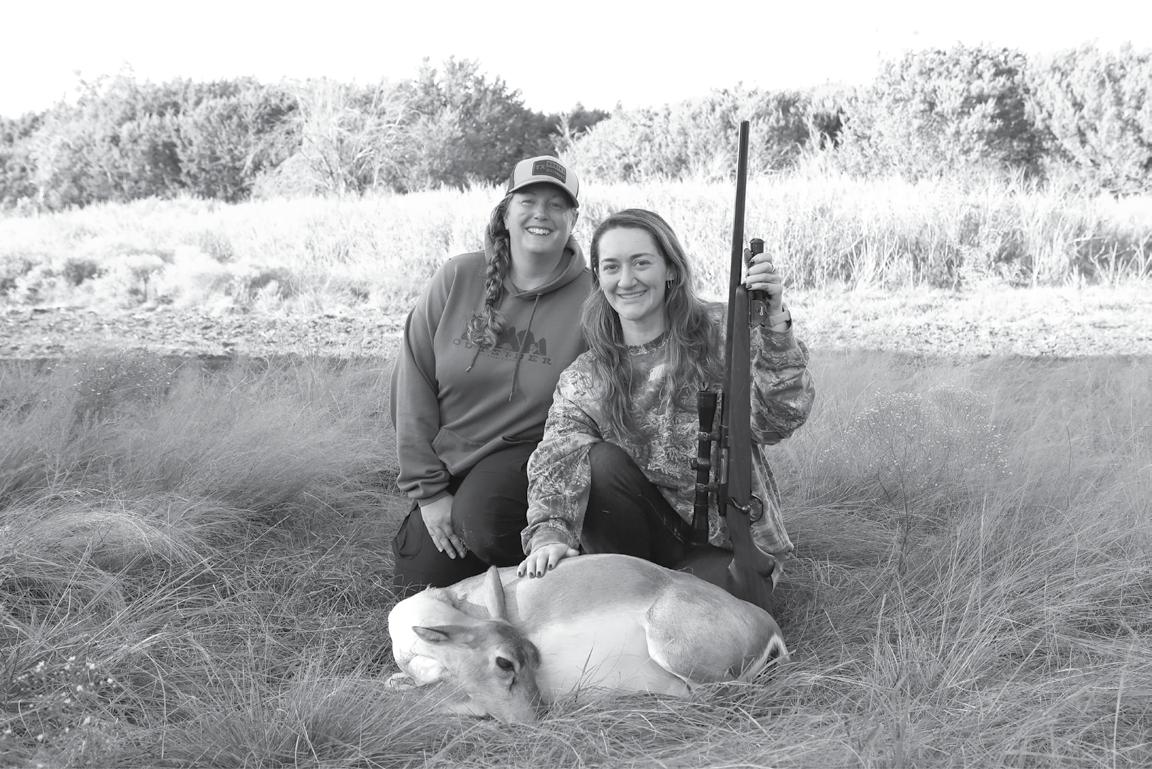
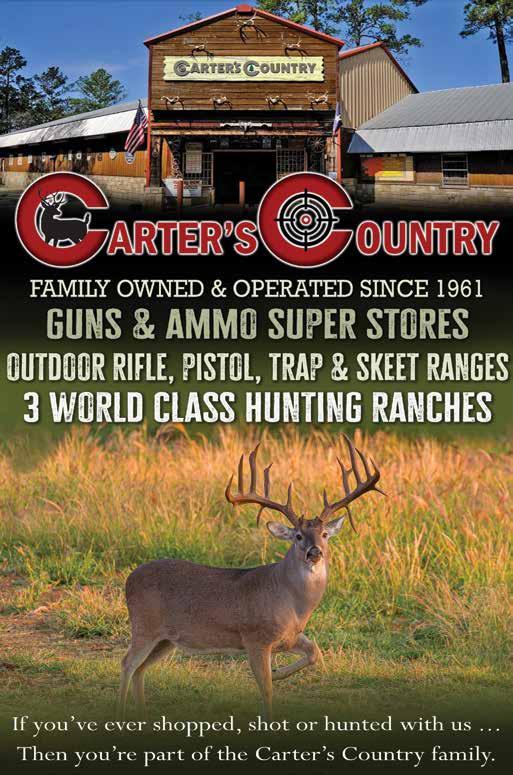
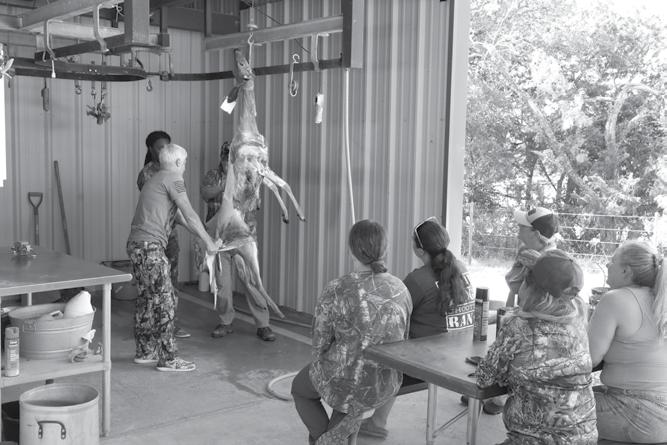
By Meghan Jackson For Lone Star outdoor newS
A group of women recently got to experience the thrill of the hunt.
Kelly Godrey was inspired to help more women get involved as she noticed immense growth within the Texas Women’s Outdoors, LLC, who hosted a recent hunt at the Sierra Mesa Ranch in Hico.
“This is our third annual mentored hunt where women are able to enjoy and learn about the entire hunting experience for a whole weekend,” Godfrey said. “We are so grateful for the Sierra Mesa Ranch and owner Rob Carringer, who allows us to make this happen.”
With five hunters and five guides (all women), Godfrey said Carringer allowed them to take the lead. Beginning on Friday, participants learn how to operate a firearm, hunt, clean their kill, and take meat home to feed their family.
“We are building a movement that celebrates heritage, strengthens conservation, and opens doors for women and families to experience the wild places that shape us,” according to the group’s website.
Known to meet the old west with southern hospitality, Oma Leen’s Chef Austin Odom taught the hunt participants about wild game processing and meat preparation.
“He demonstrated a way to cook a venison backstrap and shared tips and tricks on wild game cooking,” Godfrey said. “He even left us with a recipe for us to take home.”
Godfrey said the end results of the weekend consisted of three white-tailed does and one blackbuck doe. Overall, the largest weighed 105 pounds.
“This experience allows the opportunity to learn many lessons beyond the hunt itself,” Godfrey said. “From acquiring patience to building confidence, we are proud to serve as a support system.”
Peyton Hicks said from the moment she arrived at the ranch, she knew the weekend would be special. Little did she know she would be the hunter who harvested the blackbuck doe on the final morning.
“I was shocked by how much adrenaline I had, especially once we went out to pick her up, and I realized I had actually done it,” Hicks said. “I cannot wait to go back and continue hunting now that I have confidence in myself and my skills to do so.”
From the deer to the weather, Godfrey emphasized the importance of recognizing nature’s role and how we cannot control everything.
“Nature does its own thing and when you learn to be patient, you are able to appreciate everything that occurs around the hunt,” Godfrey said. “From the sunrise to the sunset, you are reminded to live in the moment and understand the time to harvest will come on its own.”
Funds from Lone Star Outdoor News Foundation made this hunt possible.
Nearly 250 landowners, researchers, agency staff, and students gathered in Abilene, September 17–19 for the biennial Statewide Quail Symposium. Hosted by the Rolling Plains Quail Research Foundation and partners, the event highlighted the latest science and practical strategies for quail conservation and habitat management.
The symposium opened with a field tour of Rio 42 Ranch near Lueders, where participants explored habitat treatments, plant identification, and quail-friendly grazing practices in action. The hands-on day set the stage for two days of sessions at the Abilene Convention Center.
Speakers included Texas Land Commissioner Dawn Buckingham, Texas Parks and Wildlife Upland Game Bird Program Leader Patrick Schulz, and researchers from Texas Tech, Sul Ross, and the Caesar Kleberg Wildlife Research Institute. Topics ranged from habitat management tools like prescribed fire and brush control, to parasite and disease impacts, to new technologies such as GPS tracking and remote sensing.
A common theme was that there is no “one-size-fits-all” solution: successful quail management depends on tailoring practices to local conditions. Participants also heard about funding opportunities and incentive programs that can help private landowners adopt wildlife-friendly practices.
Beyond the presentations, the symposium provided vital networking for landowners, scientists, and students committed to restoring quail populations. Attendees left with practical tools, new contacts, and renewed energy to apply research on the ground.
The event reinforced Texas’ strong tradition of collaboration around upland bird conservation and showcased the momentum building toward a future where quail remain a vibrant part of our landscapes and heritage.
— Dr. Ryan O’Shaughnessy,
RPQRF
The Rolling Plains Quail Research Ranch conducted annual roadside quail surveys during the first three weeks of September. They have two survey routes—one on the east side of the ranch and one on the west side—each route is surveyed eight times, both in the morning and evening. Across the three-week period, they observed a total of 1,636 birds, averaging 10.22 birds per mile. This is slightly below last year’s 11.7 birds per mile, but still significantly higher than counts from 2018 through 2023.
Anecdotally, quail numbers may actually be higher than last year. The increased vegetation likely reduced visibility and kept them from observing as many birds as are truly present. While this may not shape up to be a year like the record-setting 2016 season, results expect to be very similar to last year, with some pockets of excellent bird numbers around the state. Reports of quail sightings inside Abilene, Knox City and Midland city limits are always a positive sign when birds are seen in urban areas.
One concern is the recent re-emergence of drought conditions across parts of South Texas and the Rolling Plains. The Research Ranch recorded just 1.2 inches of rain in September 2025, compared to 4.2 inches in September 2024. If drought persists, quail numbers could



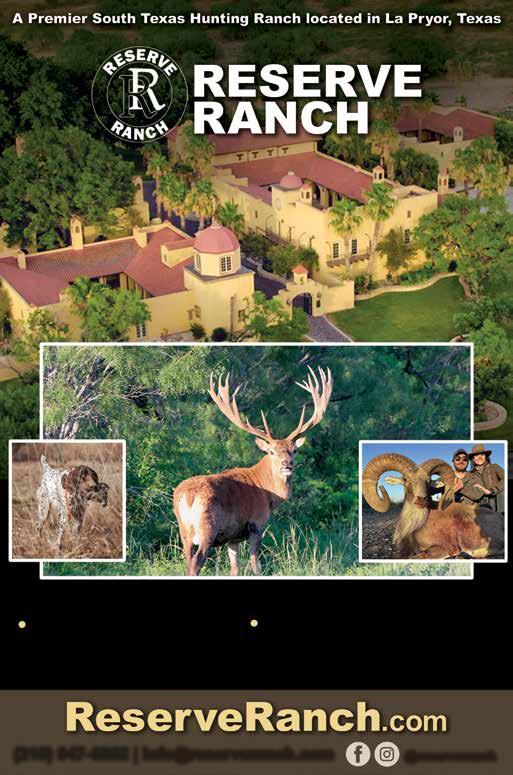


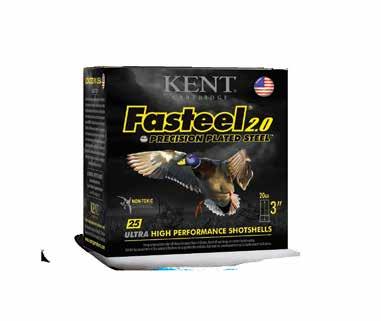





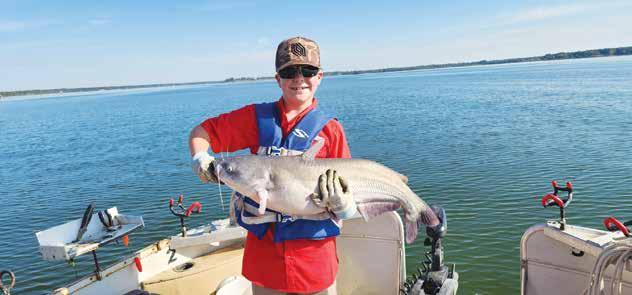
By Cory Byrnes For Lone Star outdoor newS
Trophy-sized catfish remain inconsistent for Texas anglers.
Most agree that despite the last few “cold fronts,” the water temperature just isn’t right yet. That doesn’t mean you can’t catch them, however.
“You never know when you’re going to hang a big one. If you’ve got a bait out there, it could be anywhere,” said Tony Pennebaker with Thunder Cover Guide Service.
On Lake Tawakoni, “it’s been slow, but you can catch some very good fish,” Pennebaker said. He and his clients have been catching plenty of eaters, as well as fish over 20 pounds.
“This time the bite is a little bit sluggish; it will pick up later,” Pennebaker said.
Pennebaker and his clients have been finding most of their fish in 8- to 20-feet of water using a combination of drifting, trolling with planer boards, and anchoring up. He has been using shad exclusively for bait.
“I have been using fresh shad, but not real large ones; maybe medium size,” Pennebaker said.
On Lake Calaveras, the blue cats have “been good, real good this summer,” said TJ Whitworth with TJ’s Guide Service.
He and his clients have caught fish just shy of 30 pounds this year.
“Bigger blues have slowed down. It’s been spotty; you’ve got like one week out of the month where it was good since June,” Whitworth said. “You’ll see them on your sonar. You’ll get right on top of them, and then they will move off.”
He and his clients have been finding their fish in 15- to 25-feet of water. The bigger blues have been hanging out in the 28-foot range. Punch bait has been the key to catching the fish.
“I just crank it a couple of feet off the bottom for the blues,” Whitworth said. “Sometimes when it is glass out there, I will use the trolling motor and do a real slow drift.”
The key to Calaveras is to cover water and look for rock piles.
“Anywhere there are rocks, the blues have been there,” Whitworth said.
On Lake Eagle Mountain, the trophy blues haven’t come out to play yet.
“We are just going to have to have a change in this weather pattern and a drop in water temperature,” Chad Fergusson with North Texas Catfish Guide Service said.
Catfish fishing has been good.
“The fish are moving around a lot, so you have to work a little bit harder to catch them,” Fergusson said. “As soon as this weather pattern breaks, it will get easier. There hasn’t been any rhyme or reason to it. The key is to keep moving from structure to structure. “You just have to cover water to find them.”

By Nate Skinner For Lone Star outdoor newS
Party boats from Port Aransas to Galveston Island have been taking advantage of decent offshore conditions lately. Most have been running 12- and 36-hour trips, and their anglers have been catching a plethora of species. Bottom fishing has been their main tactic and squid, Spanish sardines, and live bait have all been producing plenty of bites.
Capt. Johnny Williams with Williams Party Boats out of Galveston, said they have been running about 80 miles offshore on their recent trips, where their anglers have been catching vermillion snapper, mangrove snapper, and a variety of grouper.
“We’ve been fishing in about 170- to 180-feet of water,” Williams said. “Some of the fish that we have been catching have been suspended in the water column, but the majority of them have been holding tight to the bottom.”
According to the staff at Galveston Party Boats, Inc., their last two 12-hour trips produced good numbers of a variety of species of fish.
On one trip, anglers aboard their party boat The New Buccaneer landed 373 vermillion snapper, 43 blue runners, 3 am-
berjack, and 5 lane snapper. Anglers aboard The New Buccaneer on another trip landed 472 vermillion snapper, 18 lane snapper, 2 scamp grouper, 1 almaco jack, 1 African pompano, 9 blue runners, 4 Atlantic sharpnose sharks, and 1 scorpion fish.
Most of the fish were caught about 60- to 80-miles out offshore in 120- to 180-feet of water. Nearly all of the fish were caught on squid or Spanish sardines. Some of the larger species were caught on live baits.
Corbin Orr, a deckhand for Port Aransas Fisherman’s Wharf, said during their most recent 36-hour trip, they ran about 70 miles out offshore and bottom fished in depths anywhere from 900- to 1,200-feet of water.
“We caught 39 barrel fish, a handful of scorpion fish, and a couple of golden tilefish,” Orr said. “There were also a handful of almaco jacks caught, and we caught and released some amberjacks as well.”
Orr said squid and live pinfish were the most productive baits.
“After fishing out deep, we also ran back to shallower water and found limits of vermillion snapper in about 230 feet of water,” Orr said. “All of the vermillion snapper were caught on squid, and the majority of them were holding tight to the bottom.”
According to Orr, most of the vermillion snapper were in the 15- to 16-inch range.
By Nate Skinner For Lone Star outdoor newS
The fishing action on Canyon Lake is starting to rebound from the effects of rising water due to significant flooding back in the summertime. Largemouth bass are consistently being caught, and the striper bite is beginning to slowly pick up, too.
Canyon Lake fishing guide Capt. Steve Nixon said the lake rose 12 to 13 feet back in the summer as a result of the Hill Country floods that took place during July.
“At first, the fishing was excellent right after the water level rose,” Nixon said. “That lasted about 2 to 3 weeks. Then the bite really shut down for a while, as the water quality became poor due to all of the runoff. Luckily, the water has cleaned up quite a bit in recent weeks. The lake is beginning to stabilize, and the fishing is significantly improving.”
According to Nixon, Canyon Lake is currently about 17 feet low. He said the largemouth bass bite is starting to heat up, and most of the fish can be found in hydrilla in water depths from 10- to 25feet of water.
“The hydrilla on Canyon Lake grows out to about 26 or 27 feet deep,” Nixon said. “Some of the bass have been out deep lately, in 25-feet of water in the
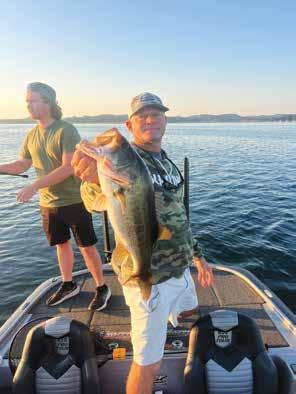
By Tony Vindell
For Lone Star outdoor newS
Three family members — almost — took the top spots at the last major fishing tournament of this year held along the Lower Laguna Madre.
The avid anglers, Charles and Guillermo Guillen, won first and second place in the redfish division in the annual Brownsville Police Officers Association surf fishing tourney held Saturday, Oct. 4, on Boca Chica Beach.
A third family member, Enrique, held third place but was bumped out less than two hours before the weighin ended.
Dubbed “Catch a Red — Help the Blue,” the event drew 118 anglers who competed for the biggest redfish and speckled trout.

There was also a kids, largest-of-the-hour, most spots on a redfish and biggest black drum competition during the 6 a.m. to 2 p.m. event.
Charles’ fish weighed 7.15 pounds and measured 27.75 inches long, while Guillermo’s fish weighed 8 pounds and was 27.50 inches long.
Angler Noemi Perez took third place. Her fish weighed 7.35 pounds and measured 26.75 inches.
The winning fish were based on the fish’s length, not weight.
Felipe Cepeda, a BPOA member, said nearly 120 people participated in the tournament.
Gary Williams, with Gordon Bait & Tackle and a longtime tournament sponsor, said very few kids fished largely because the surf was too rough.
Guillen, the redfish winner, said fishing was hard, the waves were rough and debris was everywhere.
“I don’t’ normally have the opportunity to fish on weekends so I thought, let’s go in and give it a shot,” he said. “It turned out good for us.”
The BPOA tournament has been going on during the month of July for the last 35 years, but its organizers began rescheduling it to the month of October for the last three years.
They said too many summer tourneys were impacting their fundraising efforts.
And why not have it in the month of October when the bull redfish run is in full force?
According to angler reports, the waters off the Cayman Bridge on Texas Highway 48 have been inundated with people catching redfish.
The same has been going on at the north jetty off South Padre Island and at the south jetty off Boca Chica Beach.
Dallas/Ft. Worth angler Bryan Howell earned the victory at the Newport Bassmaster Kayak Series at Toledo Bend Reservoir with a two-day total of 179 inches, earning the $7,600 firstplace prize and a trip to the 2026 Bassmaster Kayak Series National Championship.
The Texas resident opened the tournament in the lead with 92.25 inches before adding 85.75 inches on the final day to take home the trophy.
“I barely got any practice. I was lucky to be here honestly,” Howell said. “I knew I had to fish this one. It’s a Texas lake that has grass, and I’m pretty good on these types of lakes.”
Targeting submerged grass turned out to be the key to success for Howell on Day 1 with the majority of his bites coming between 4 and 8 feet of water. He used a multitude of presentations, including a buzzbait, walking top-water and a Z-Man JackHammer.
The Bass Pro Shops Big Bass Bash, the Association of Collegiate Anglers’ first event of the 2025-26 season, was contested at Kentucky Lake Sept. 20-21. Each of the Top 10 finishing anglers in this tournament earned automatic qualification into the 2026 Collegiate Bass Fishing Championship.
Here is a look at the Top 10 in the final tournament standings:
Jared Mizell – Tarleton State University
Hunter King – Blue Mountain Christian University
Braylon Eggerding – Adrian College
Alex Gore – Carson-Newman University
Dalton DeFelice – University of Montevallo
Harrison McCall – Lander University
Joe Vaulton – Carson-Newman University
Kase Kramer – Tarleton State University
Preston Anderson – Bethel University
Dawson Lynch – Tarleton State University
The Texas Parks and Wildlife Department has chosen 11 new projects to be supported by the Habitat and Angler Access Program during its 2026-27 funding cycle. Launched in summer 2021, the Habitat and Angler Access Program is primarily funded by the purchase of freshwater fishing licenses.
Projects selected to be funded and completed during 2026-2027 are listed below:
Kirby Reservoir Multiuse Pier Project
Fort Phantom Hill Reservoir Multiuse Pier Project
City of Big Spring Comanche Trails Pier Project
Lake Stamford Anchor Marina Crappie House Replacement
City of Coleman Memory Lake Habitat and Access Project
Lake Brownwood Fish Habitat Project
City of Grapevine Settler’s Park Angler Access Project

ALAN HENRY: 76 degrees; 2.67’ low. Crappie are fair on minnows. Catfish are fair on punch bait.
AMISTAD: Water very stained 81 degrees; 59.46’ low. Largemouth bass are fair on top-waters and spinnerbaits.
ARLINGTON: Water slightly stained; 90 degrees; 2.61’ low. Largemouth bass are slow. Crappie are good on minnows and jigs. White bass are good on slabs. Catfish are good on cut bait.
ARROWHEAD: Water stained; 80 degrees; 1.54’ low. Largemouth bass are slow. White bass are fair on crankbaits. Crappie are slow. Catfish are fair on fresh cut shad.
ATHENS: Water stained; 85 degrees; 0.13’ high. Largemouth bass are fair on stick baits, soft jerk baits, hollow body frogs, and spinnerbaits. Crappie are good on jigs and minnows.
AUSTIN: Water clarity good; 82 degrees; 0.62’ low. Largemouth bass are good on soft plastics.
B A STEINHAGEN: Water stained; 87 degrees; 0.20’ low. Largemouth bass are slow.
BASTROP: Water stained; 93 degrees. Largemouth bass are good on swimbaits, Carolinarigged flukes, and shaky head worms.
BELTON: Water stained; 83 degrees; 0.04’ high. White bass and hybrid striped bass are fair on pet spoons and slabs. Catfish are good on fresh cut bait, punch bait, and live bait.
BENBROOK: Water stained; 82 degrees; 2.52’ low. Crappie are good on minnows. Catfish are good on cut bait and punch bait. Hybrids are fair on live bait.
BOB SANDLIN: Water stained; 87 degrees; 0.75’ low. Crappie are good on jigs and minnows.
BOIS D’ARC: Largemouth bass are fair on buzz baits, frogs, flukes, soft plastic stick baits, and Texas-rigged creature baits. Crappie are good on minnows and jigs.
BRAUNIG: Water stained; 88 degrees; Largemouth bass are slow. Redfish are fair on soft plastics and jigs. Catfish are slow.
BRIDGEPORT: Water clear; 80 degrees; 2.75’ low. Crappie are good on minnows and jigs. Largemouth bass are fair on top-waters, crankbaits, and spoons. White bass and hybrids are fair on top-waters, slabs, and trolling. Catfish are good on cut bait and live bait.
BROWNWOOD: Water stained; 79 degrees; 1.56’ low. Largemouth bass are good on topwater frogs, chatterbaits, crankbaits, and jigs. Crappie are good on minnows and jigs. White bass are slow. Catfish are fair on cut shad and perch.
BRYAN: Water stained; 85 degrees. Largemouth bass are fair on finesse style baits.
BUCHANAN: Water slight stain; 84 degrees; 1.64’ low. Striper are fair trolling and on top-waters. White bass are good on top-waters and swimbaits. Crappie are fair on minnows. Catfish are fair on punch bait and cut shad.
CADDO: Water stained; 83
degrees; Largemouth bass are good on flukes, Rattletraps, topwater lures, and plastic worms.
CALAVERAS: Water stained; 89 degrees; Redfish are good on spoons and soft plastics. Catfish are good on punch bait.
CANYON LAKE: Water stained; 85 degrees; 17.34’ low. Largemouth bass are fair flipping Texas-rigged soft plastics. Striper are fair on jigging spoons.
CEDAR CREEK: Water slightly stained; 77 degrees; 1.71’ low. Hybrids are good on slabs and spinnerbaits using the saw tooth retrieve technique. White bass are good trolling spoons. Catfish are good on cut bait.
CHOKE CANYON: Water stained; 88 degrees; 37.61’ high. Catfish are fair on stink bait and cut bait.
CISCO: Water stained; 87 degrees; 15.28’ high. Largemouth bass are fair on soft plastics.
COLEMAN: Water stained; 82 degrees; 2.13’ low. Largemouth bass are fair on small finesse worms. Crappie are good on jigs and minnows.
COLETO CREEK: Water stained; 91 degrees; 1.71’ high. Largemouth bass are slow. Crappie are fair, with decent action coming off brush piles.
CONROE: Water stained; 86.4 degrees; 0.36’ high. Largemouth bass are fair on soft plastics and crankbaits. Crappie are fair on minnows and jigs. Hybrids and white bass are good on slabs, spoons, and shad. Catfish are good on punch bait, liver, and worms.
COOPER: Water stained; 78 degrees; 2.02’ low. Crappie are slow.
CORPUS CHRISTI LAKE: Water stained; 84 degrees; 16.09’ low. Largemouth bass are slow.
CYPRESS SPRINGS: Water stained; 85 degrees; 0.50’ low. Crappie are good on jigs and minnows.
EAGLE MOUNTAIN: Water stained; 80 degrees; 1.89’ low. Largemouth bass are fair on spinnerbaits and jerk baits. White bass are slow. Crappie are fair on minnows and jigs. Perch are good on nightcrawlers. Carp and buffalo are good on sweet corn. Catfish are good on manufactured bait and cut bait.
FALCON: Water stained; 87 degrees; 47.02’ low. Largemouth bass are fair on Senkos and square bill crank baits.
Gar are good on carp and cut tilapia. Catfish are good on live bait and cut bait.
stained; 80 degrees; 4.53’ low. Largemouth bass are slow. Crappie are fair on minnows and jigs.
GEORGETOWN: normal stain; 82 degrees; 5.53’ high. Largemouth bass are fair on reaction baits and moving baits.
GRAHAM: Water stained; upper 80 degrees; 2.51’ low. Largemouth bass are good on shad imitation baits. Crappie are fair on minnows. Sand bass and hybrids are good on spoons and cut shad. Catfish are good on cut shad.
GRANBURY: normal stain; 83 degrees; 0.72’ low. Largemouth bass are good on shallow crankbaits. Crappie are good on minnows and jigs. Striped bass are slow. White bass are good on slabs. Catfish are good on cut bait.
GRANGER: Water stained; 82 degrees; 0.02’ high. Largemouth bass are fair on worms and crankbaits. Crappie are good on minnows. White bass are fair on slab spoons. Catfish are good on shad.
GRAPEVINE: Water clear to slightly stained; 80 degrees; 0.51’ low. White bass are good on in-line spinners and slabs.
GREENBELT: Water stained; 85 degrees; 49.64’ low. White bass are good on minnows. Crappie are slow.
HAWKINS: Water slightly stained; 86 degrees. Largemouth bass are good on top-waters. Bream are good on small poppers.
HOUSTON: Water clear; 86 degrees; 0.04’ high. Largemouth bass are good on grubs, Texas-rigged worms, crankbaits, and spinnerbaits. Crappie are good on minnows and jigs. White bass are good on pet spoons. Catfish are good on fresh-caught shad.
HOUSTON COUNTY: Water stained; 86 degrees; 0.08’ high. Largemouth bass are fair on reaction baits.
HUBBARD CREEK: Water Stained; 80 degrees; 12.93’ low. Largemouth bass are slow. Crappie are fair on minnows and jigs.
INKS: Water stained; 85 degrees; 0.76’ low. Largemouth bass are fair on reaction baits.
JACKSONVILLE: Water stained; 87 degrees; 0.01’ high. Largemouth bass are fair on soft plastics and top-waters.

FAYETTE: Water slightly stained; 85 degrees; full pool. Largemouth bass are good on underspins, Carolina rigs, and Rattletraps.
FORK: Normal stain; 85 degrees; 1.29’ low. Largemouth bass are good on top-waters, frogs, flukes, and soft plastics stick baits. Crappie are good on jigs and minnows. FT PHANTOM HILL: Water
LAKE O’ THE PINES: Water stained; 86 degrees; 0.98’ high. Largemouth bass are good on top-waters and lipless crankbaits. Crappie are slow. Catfish are fair on cut bait.
LAVON: Water stained; 86 degrees; 2.03’ low. Largemouth bass are good on spinnerbaits, crank baits, and soft plastics. Crappie are fair on jigs. White bass are fair on slabs and jigs. Catfish are good on cut shad, bluegill, and drum.
LBJ: Water stained; 81 degrees; 0.68’ low. Largemouth bass are good on spinnerbaits and Texas-rigged soft plastics. Crappie are good on jigs. Catfish are fair on punch bait.
LEWISVILLE: Water stained;
82 degrees; 0.75’ low. White bass are fair on slabs, spoons, spinnerbaits, and live bait. Hybrid striper are slow. Crappie are slow. Catfish are fair to good on cut shad and punch bait.
LIMESTONE: Water clear; 84 degrees; 1.11’ low. Largemouth bass are good on Texas rigs, spinnerbaits, and Carolina rigs. Crappie are good on minnows. White bass are fair on spoons. Catfish are fair on cut bait and minnows.
LIVINGSTON: Normal stain; 87 degrees; 0.29’ high. White bass are good on slabs. Catfish are fair on shad.
MARBLE FALLS: normal stain; 85 degrees; 0.50’ low. Largemouth bass are fair on reaction baits.
MARTIN CREEK: Water slightly stained; 87 degrees; 1.21; low. Largemouth bass are good on chatterbaits, swimbaits, and Texas-rigged worms. Crappie are fair on jigs and minnows.
MEDINA: Water lightly stained; 87 degrees; 80.93 feet below pool. The lake is very low at only 6.4 percent full. Medina Lake is closed due to low water levels.
MEREDITH: Water stained; 79 degrees; 42.98’ low. Largemouth bass and smallmouth bass are good on crankbaits, jointed baits, and topwater lures. Crappie are fair on jigs. Bluegill and perch are good on worms and corn. Walleye are good on jigs. Catfish are good on minnows, worms, stinkbait, and frozen shrimp.
PALESTINE: Water stained; 81 degrees; 0.19’ low. Largemouth bass are good on soft plastics. Crappie are good on jigs. Catfish are good on cut bait and punch bait.
PALO PINTO: Normal stain; 86 degrees. Largemouth bass are slow. Crappie are fair on minnows. Sand bass and hybrids are slow. Catfish are good on fresh cut shad.
PINKSTON: Water stained; 81 degrees. Largemouth bass are good on swimbaits and crankbaits. Crappie are slow. Catfish are fair on live minnows and cut baits.
POSSUM KINGDOM: Water stained; 82 degrees; 1.19’ low. Largemouth bass are good on top-waters, crankbaits, and Texas-rigged worms. Striper are slow. White bass are fair on slabs. Crappie are good on minnows. Catfish are fair on shad.
PROCTOR: Water stained; 87 degrees; 1.61’ low. White bass and hybrids are fair on topwater lures. Catfish are good on worms and cut bait.
RAVEN: Water slightly stained; 88 degrees. Largemouth bass are good on chatter baits and Texas-rigged worms.
RAY HUBBARD: Water stained; 83 degrees; 1.07’ low. White bass are fair on swimbaits, tail spinners, and Rattletraps. Crappie are slow. Catfish are fair on punch bait.
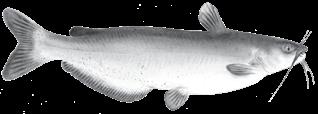
RAY ROBERTS: Water slightly stained; 82 degrees; 0.93’ low. Largemouth bass are good on jigs and shad imitation baits. Crappie are fair on minnows and chartreuse jigs.
MILLERS CREEK: Water stained; 85 degrees; 2.61’ low. Crappie are good on jigs and minnows. Largemouth bass are good on spinnerbaits, crankbaits and buzzbaits.
NACOGDOCHES: Water heavily stained; 82 degrees; 1.47’ low. Largemouth bass are good on jigs, bladed jigs, soft plastics, and top-waters. in the shallow water. Crappie are good on jigs. Catfish are slow.
NACONICHE: Water heavily stained; 81 degrees; full pool. Largemouth bass are fair on frogs and other topwater baits. Crappie are good on jigs and minnows. Catfish are slow.
NASWORTHY: Water slightly stained; 85 degrees; 0.99’ low. Largemouth bass are fair on top-waters and flipping soft plastics. Crappie are fair on jigs. Catfish are fair on cut bait and stink bait.
NAVARRO MILLS: 85 degrees; full pool. Catfish are good on cut bait and punch bait. White bass are fair trolling. Crappie are fair on minnows.
O H IVIE: Water stained; 81 degrees; 17.91’ low. Largemouth bass are fair on soft plastics and top-waters. Crappie are good on minnows and jigs. Catfish are good on cut shad, perch, and stink bait.
OAK CREEK: Water lightly stained; 84 degrees; 21.17 feet below pool. Largemouth bass are slow. Crappie are slow.
RICHLAND CHAMBERS: Water slightly stained; 85 degrees; 0.81’ low. Largemouth bass are fair on soft plastics and square-billed crankbaits. Catfish are good on cut bait and punch bait. Hybrids and white bass are slow.
SAM RAYBURN: Water stained; 80 degrees; 7.35’ low. Largemouth bass are fair on topwater frogs, Senkos, crankbaits, jigs, and Carolina rigs. Crappie are fair on minnows and jigs. White bass are fair on slabs. Catfish are good on cut bait.
SOMERVILLE: Water stained; 81 degrees; 0.73’ low. Largemouth bass are slow. Crappie are fair on jigs and minnows. White bass are fair trolling spoons. Hybrids are slow. Catfish are fair on cut shad and punch bait.
SPENCE: Water stained; 80 degrees; 49.67’ low. Catfish are good on punch bait and fresh cut bait.
STAMFORD: Water stained; 84 degrees; 0.49’ high. Largemouth bass are good on soft plastics. Crappie are fair on minnows and jigs. Catfish are slow.
STILLHOUSE: Water stained; 83 degrees; 0.03’ high. Largemouth bass are fair on soft plastics. White bass and hybrid striper are fair on slabs and downriggers.
TAWAKONI: Water lightly
stained; 80 degrees; 0.77’ low. Largemouth bass are fair on shaky heads and frogs. Hybrid striper and white bass are good on slabs. Crappie are slow. Catfish are good on prepared baits and cut shad.
TEXANA: Water stained; 78 degrees; 2.93’ low. Crappie are slow. Catfish are good on jug lines and trotlines.
TEXOMA: Water stained; 84 degrees; 0.21’ high. Largemouth bass are good on reaction baits and soft plastics. Smallmouth bass are fair on soft plastics. Striped bass are fair on swimbaits and small topwaters. Catfish are good on cut shad and punch bait.
TOLEDO BEND: 88 degrees; 4.00’ low. Largemouth bass are fair on Texas rigs and crankbaits. Crappie are slow.
TRAVIS: Water stained; 85 degrees; 8.80’ low. Largemouth bass are fair on Texas rigs and drop shots.
TWIN BUTTES: Water stained; 82 degrees; 33.55’ low. Largemouth bass are slow. Catfish are fair on punch bait.
TYLER: Water stained; 82 degrees; 0.87’ low. Largemouth bass are good on trick worms, spinnerbaits, and crankbaits. Bream are good on red worms. Crappie are good on minnows. Catfish are good on liver.
WACO: Water stained; 90 degrees; 0.18’ high. Crappie are good on minnows and jigs.
WALTER E LONG: Water stained; 88 degrees. Largemouth bass are fair on spinnerbaits, crankbaits, jerkbaits, soft plastics, and chatterbaits.
WEATHERFORD: Water stained; 88 degrees; 4.82’ low. Largemouth bass are slow. Crappie are fair on minnows and shad. Catfish are fair on cut bait and shrimp.
WELSH: Water stained. 88 degrees. Crappie are fair on minnows.
WHITE RIVER: Water stained; 78 degrees; 17.45’ low. Crappie are fair on minnows and jigs. Catfish are fair on live bait.
WHITNEY: Water clear; 85 degrees; 0.56’ low. Largemouth bass are good on soft plastics. Striped bass are slow. Crappie are fair on minnows and jigs. White bass are slow. Catfish are good on punch bait.
WORTH: Water stained; 84 degrees; 1.03’ low. Largemouth bass are good on top-waters and soft plastics. Crappie and sand bass are slow. Catfish are good on cut bait.
WRIGHT PATMAN: Water stained; 80 degrees; 4.56’ high. Crappie are good on jigs and minnows.

Continued from page 1
response to a formal notice from National Oceanic and Atmospheric Administration Fisheries’ Office of Law Enforcement and Office of Protected Resources that a formal investigation into TPWD was being launched over alleged violations of the Marine Mammal Protection Act and the Endangered Species Act.
The alleged violations arose from incidental and rare encounters with bottlenose dolphin and sea turtles that have taken place throughout TPWD’s gill net sampling efforts over more than four decades. In an act to work in good faith with NOAA, TPWD has reported these encounters as they have occurred over the years, as a part of its normal operating processes for the gill net sampling program.
“Since 1983, TPWD has recorded 41 dolphin encounters,” Geeslin said. “That’s an average of about one per year, across over more than 30,000 gill net sets. Not to mention, the majority of these dolphins were released alive.”
Geeslin said that TPWD has recorded approximately 300 sea turtle encounters throughout their gill net sampling efforts since 1983, with less than half of those resulting in mortalities. He also confirmed that during the over 40-year stretch, TPWD participated in the rescuing, rehabilitation, and reintroduction of thousands of sea turtles along the Texas coast.
“We have asked NOAA many times since we received their notice of investigation back in May of 2024, what the status of their investigation is,” Geeslin said. “We have also asked them exactly who or what within TPWD is under investigation. They have refused to provide us with any specific details or answers to either of those questions.”
According to the Chief of Science and Policy Resources branch for the TPWD Coastal Fisheries Division, Tiffany Hopper, TPWD has applied for incidental take authorization permits for dolphin and sea turtles multiple times over the last decade. The most recent application was submitted earlier this year; however, NOAA has yet to issue these permits.
“The permits remain in process with NOAA, as they continue to make additional requests for information and details from the department,” Hopper said. “TPWD is continuing to attempt to work in good faith with NOAA to answer their requests in hopes to obtain these permits.”
Hopper said NOAA has granted similar incidental take authorization permits to a variety of other entities, including private companies and organizations for activities involving marine mammals and endangered species. Some of these entities have publicly documented higher rates of encounters with marine mammals and endangered species than TPWD.
This inconsistency raises concern and suggests that NOAA could be selectively applying its regulatory authority in a way that undermines TPWD’s goals and mission. According to TPWD, the entire process of the investigation by NOAA, along with their communication with TPWD, and their long, drawn-out, and opaque means of issuing incidental take permits, wreaks of bureaucratic nonsense. Geeslin said it leaves TPWD caught between its legal obligations and its scientific mission of managing and improving our coastal fisheries.
“It appears NOAA is attempting to further delay the review and the issuing of these permits,” Geeslin said. “Despite our efforts to work in good faith with NOAA, they continue to draw out the process.”
Geeslin encourages anyone who is concerned about the status of this issue and the future of our state’s gill net sampling program to reach out to their elected congressmen and senators.
CCA Texas Advocacy Director Shane Bonnot said it’s important for folks to realize dolphin populations have increased by as much as 2,700% in parts of the Texas coast since the early 1990s. This only reinforces that the impact of TPWD’s gill net program is negligible.
“Dolphin interactions are becoming a major problem for our fisheries, especially when folks are trying to safely release fish while practicing
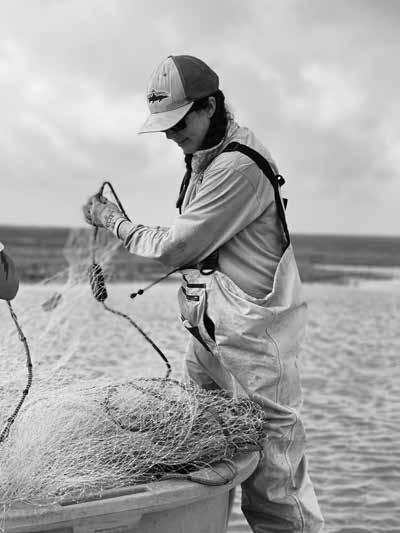
catch and release,” Bonnot said. “Dolphins are very comfortable around fishing activity and boats and seem to be relying more and more on angler presence for locating their food supply. Gill nets are not the issue. The issue is we have a lot more dolphins than we’ve ever seen, and they are more comfortable around us than they’ve ever been.”
Bonnot said without gill net sampling, Texas is forfeiting a vital tool for the management of its coastal fisheries.
“We just can’t make accurate decisions without the data the gill net sampling program provided us with,” Bonnot said.
Requests for comment from NOAA went unreturned.
A college student missing for several days on Toledo Bend Reservoir on the Texas and Louisiana border was found dead on Friday, Sept. 26.
Peyton Hughes, 21, a student enrolled at Campbellsville University in Kentucky, was prefishing for a Bassmaster Kayak Series event, set to take place September 27-28, when he was reported missing, the Texas game wardens said.
According to a statement by the Bass Anglers Sportsman’s Society, Hughes didn’t return to the launch point, the designated meeting place, on September 24. His travel partner contacted authorities.
—Staff report
A man is dead after a boat struck a pier early Saturday morning in Baffin Bay in Kleberg County.
Authorities said the crash happened around 6:04 a.m. The victim has been identified as longtime Baffin Bay fishing guide Craig West, 62, of Rivera, Texas.
The Kleberg County Sheriff’s Office and Texas Parks and Wildlife are investigating the incident to determine what happened.
—Staff report



Continued from page 4
grabbed my bow, and got ready to shoot.”
Friedrichs said the buck was extremely cautious as he made his approach towards the feeder. The deer stopped about 30 yards away from the stand.
“He was standing perfectly broadside, and I knew this was my chance,” Friedrichs said. “I had been practicing shooting out to 30 yards a lot in my back yard and was confident I could make a good shot.”
The young archer drew his bow back, found his anchor point, and released his arrow. Reacting to the sound of the arrow releasing, the buck spun; however, the arrow struck him just inside the shoulder, piercing the vitals.
“We watched him run about 80 yards, before piling into some brush,” Friedrichs said. “I wasn’t sure if I had made a good shot at first, but luckily my dad was able to film it on his phone. We played the video back and confirmed that the arrow hit him in the vitals.”
Friedrichs and his dad found the deer lying about 15 yards into the brush where they last saw him disappear, just under 100 yards from where the arrow struck him. From there, the celebration began.
Continued from page 4
The South Texas Plains is the region with the best forecast.
The survey puts the average number of bobwhites seen per route at 17.70, compared to 9.13 the year before.
The count was above the mean of 9.78 over a 15-year period.
The last harvest report showed that 20,370 hunters harvested 291,658 birds during 78,086 days of hunting.
By comparison, the 2020-24 five-year harvest report showed that 18,281 hunters harvested 250,397 birds in 75,326 days.
The High Plains region forecast showed the average number of bobwhites per route was 4.44, compared to 3.78 last year, a count below the 15-year mean of 6.44 but a slight increase from 2024.
Quail experts said the Texas quail population is in excellent shape and they attribute this to Mother Mature.
“There was a good carryover going into the spring as well as good habitat conditions,” said Patrick Schutz, the Upland Game Bird Program Leader with TPWD. “It has been so critical seeing those birds responding positively.”
Although quail populations can be up one year and down the next, quite a few birds were observed during the routes, particularly in deep South Texas.
According to the forecast, this region remains a stronghold for quail and gets even better the further one goes down to places like Brooks, Kenedy and Willacy counties.
Hall County in the Panhandle and Schackelford County near Abilene also hold healthy quail populations.
Jay Stine, the executive director with Park Cities Quail Coalition, said the bobwhites benefitted from good rains and lower temperatures this year.
“I believe it has been a good summer,” he said. “The weather has been the bigger factor.”
Although there were reports about eye worms affecting the quail, that was prevalent in West and North Texas, Stine said. The forecast is fueling high expectations and good hunting opportunities going into the 2025-26 quail season, scheduled to take place from Nov. 1 through Feb. 28, 2026, statewide.
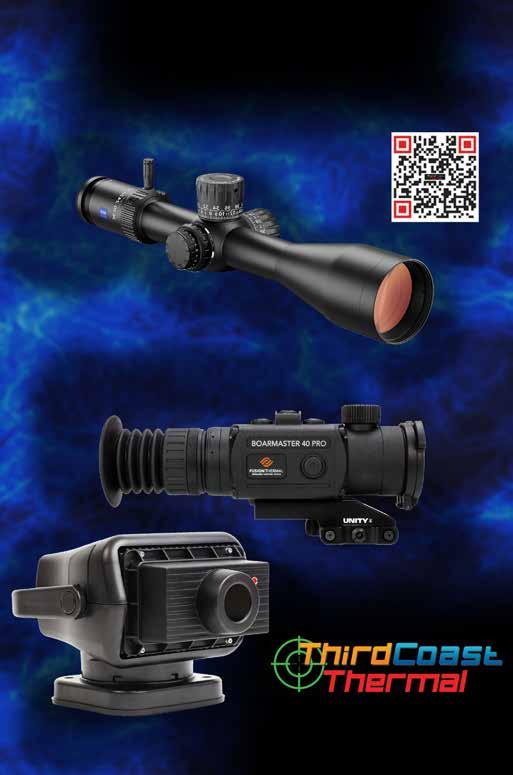







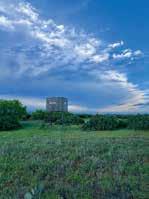



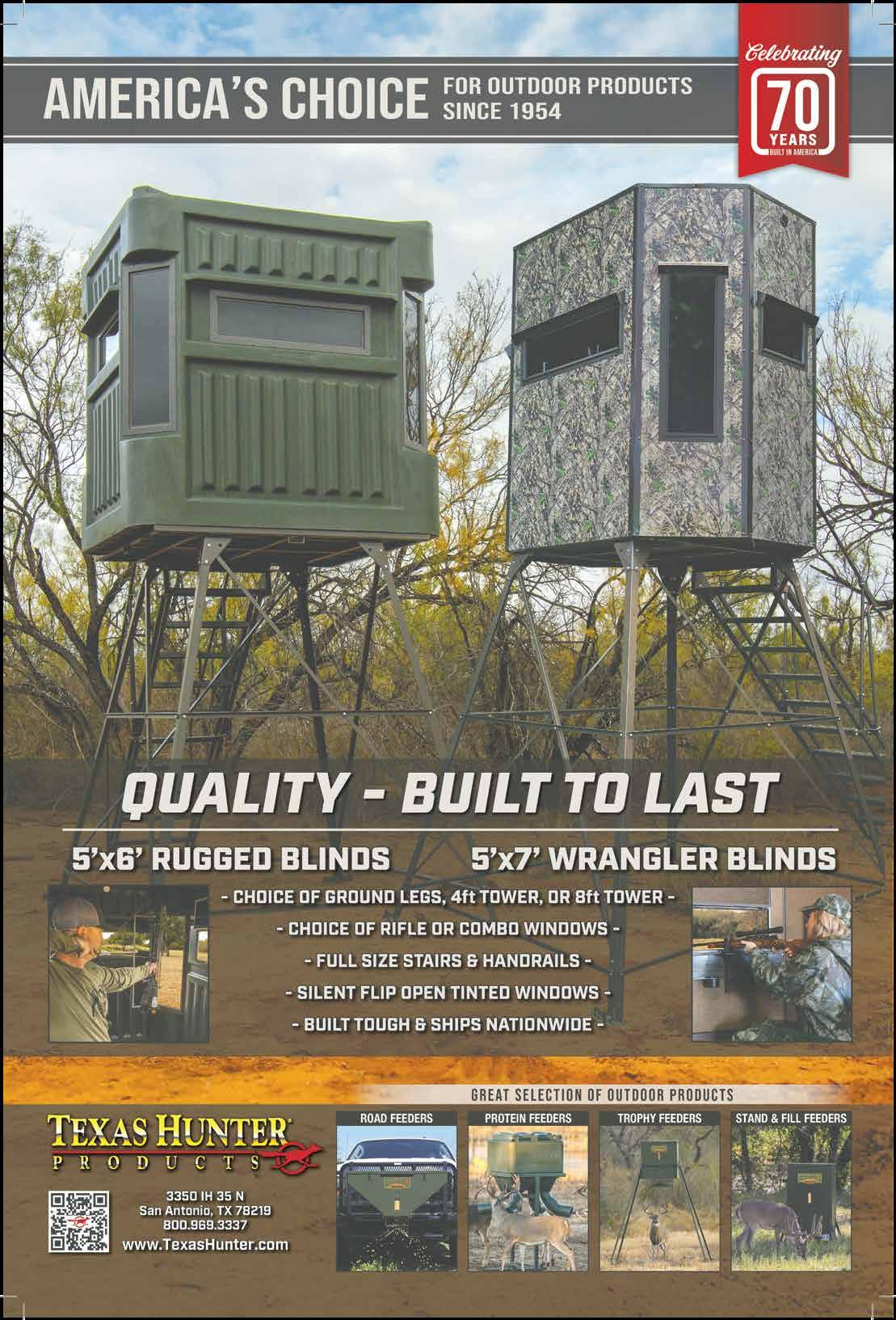
By Craig Nyhus Lone Star outdoor newS
It’s finally time — after months of thinking about it, you’re headed to the lease — better late than never.
School and family activities have kept you away, but now that archery season is here and the general season is around the corner, no excuses work, whether reasonable or not.
As you make the several-hour drive, you can see the conditions are optimal, with tall, green vegetation all along the way.
But you wonder about the summer storms that hit the county where the lease is located.
Are the blinds and feeders still standing?
Did the hail break the blind windows?
What creatures might have set up residence in the blinds?
Finally, you arrive. The vegetation is so tall you wonder if you’ll be able to see the deer. You pass by one of the lease’s oak mottes, and acorns nearly cover the ground.
You get to the first blind and feeder. The blind is standing, but the back window has been busted by the hail. You know it might take weeks to get and install a new window, so you check the blind for critters, and fortunately it is absent of unwanted visitors. You board up the window — you rarely look in that direction anyway — and proceed to clean up with your portable vacuum and Windex.
The feeder seems fine, but you replace the batteries anyway. Once you add the corn which, given the amount of acorns might be left alone for a while, you set THE-TIMER and hit the test button. It works, so you move on, hoping the deer will come.
You took the trail cameras down after last season, so you set them, hoping your phone will ding from deer, and not so much from coons and hogs.
Finally, you realize you have to do some clearing around the feeder. The push mower and weedeater are in the back of the truck, so you proceed to making the area a little more hunterfriendly.
The process repeats at the other hunting spots, with similar issues and, after a full day, you’re as ready as you can be, despite the late start.
Deer season is here, and soon you’ll be in the blind with the kids. Hopefully, activities at school will slow down or maybe take second fiddle to time in the field, and maybe even that buck you saw at the tail end of last season will make an appearance.
Deer season is here.
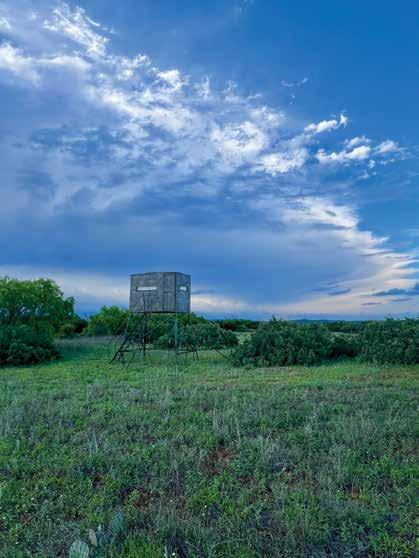




EXPERIENCE THE ULTIMATE 4X4, PAIRED WITH UNPARALLELED CUSTOMER SERVICE.


Perched atop a mesa just west of Fort Worth, Greystone Castle is a sight to behold. With four turrets peeking above the tree line, this majestic sight is one to be remembered. From its award-winning wingshooting program to trophy whitetail and exotics, world-class bass fishing and our National Champion Sporting Clays instructor, there is something for everyone at Greystone Castle.
The Gold Medal whitetail deer program offers an all-inclusive package based on the opportunity to hunt the opening weekend of the season. Not restricted by score, it is an exclusive chance to hunt for the whitetail of your dreams.
As evidenced by being named a three-time Orvis Wingshooting Lodge of the Year, Greystone has mastered the art of bird hunting. The ever-popular mixed bag hunt includes quail, pheasant, chukar and Hungarian partridge. This upland walking hunt allows guests to experience great pointing dogs working over rolling terrain specially farmed for optimal bird habitat. The European pheasant hunt is a great way to get lots of shooting action and watch Labradors do what they do best — retrieve birds. The mallard hunts offer a great chance to improve your skills over water while the fast-flying dove hunts offer an adrenaline rush every hunter craves.
If you are looking for something different, you will find it in the exotic pasture full of animals from around the world. Species from Africa, Asia, South America and Europe roam the Texas plains and thrive in the southern climate. Breeding herds of axis deer, aoudad, blackbuck antelope, sika and fallow deer
mean there are plenty of trophies to be taken. For those looking to relax and enjoy the water, Greystone offers more than 120 acres of stocked bass lakes. From small private lakes to the 80-acre Thurber Lake, every type of fishing opportunity exists. From fly-fishing to spincasters or simple hook and bobbers, there is a method for everyone. Kayaks and paddleboards let you go off on your own adventure or you can jump on a pontoon boat to sneak to the honey holes.
Two championship sporting clays courses, two 5-stands, a training course and a wobble deck challenge every level of shooter. Our new 400-yard rifle and pistol range offers steel targets at a variety of distances. Hone your skills on the new archery course featuring a tri-level static range and a 3-D walking course. Or just enjoy the scenic hiking and biking trails.
What appeals to Greystone visitors is its top-of-theline accommodations and gourmet meals. Guests enjoy 26 private rooms, gourmet dining from an executive chef, conference facilities and a swimming pool with a hot tub and a steam room. Along with this is the 2,600 square-foot pavilion facility with a custom bar, large seating areas, 65-inch TVs, carved limestone fireplace, Laser Shot, billiards and an overlook terrace with a custom outdoor fire pit.
The ownership and staff are dedicated to creating one of the finest sporting experiences found anywhere in the world. Long-term habitat improvements and wildlife management have made Greystone an extraordinary hunting venue.
GREYSTONE CASTLE
(800) 399-3006

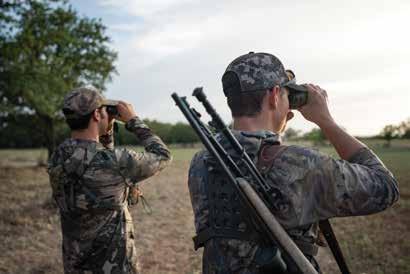
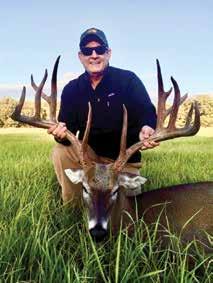
Even for outdoor activities, everyone shops online — and J&L Hunting Stores makes it easy. Shop online, call, text or email — we will have everything ready and load it for you. Or, if you prefer, we offer both delivery and setup.
Just show up and hunt.
Call, text, or come see us for easy, no-hassle shopping or shop online 24/7. J&L offers the largest inventory of deer blinds and wildlife feeders and is your full-service shop for hunters, with convenient curbside pickup and turn-key delivery available.
Spend all of your time enjoying the important things like making memories with family and friends hunting, enjoying the outdoors and Texas wildlife.
Call and schedule a delivery or just come and see us. We’re owned and operated by hunters.
If you don’t already know us ... you’ll feel like you do.


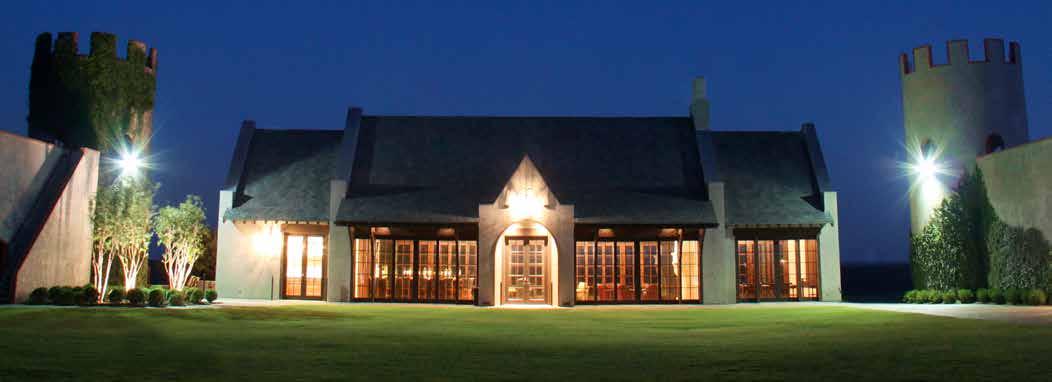


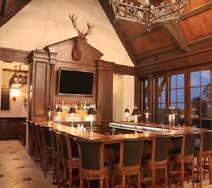

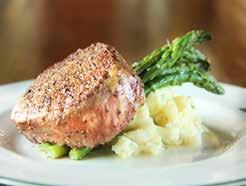



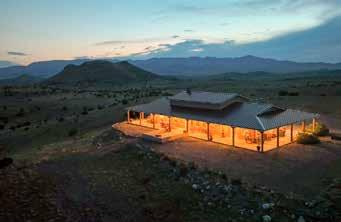
25,244± total acres | $10,000,000 | Socorro County, New Mexico

4,371.04± Deeded • 6,400± NM State Lease • 8,273± acres • 6,200 USFS acres
The 3H Bear Peak Ranch, located in Central New Mexico in Famed GMU 17 offers not only exceptional big game hunting, but also fantastic grazing opportunities. Situated along the western slope of the Magdalena Mountain Range, the Devils Backbone Wilderness Study Area, and adjoining the Cibola National Forest, the ranch has an exceptional blend of rolling grass prairies ascending to rugged mountains.
Renowned for quality big game hunting within the confines of New Mexico’s famed GMU 17, many outfitters and guides consider Unit 17 to be one of their top choices, if not their overall favorite. This area is known to hold some of the biggest bull elk in New Mexico. Elk hunting in Unit 17 is one of New Mexico’s primitive weapons only units, however, rifle hunting for elk is allowed in the Secondary Zone. Part of the draw to this area is that the terrain is rugged and physically demanding. Pronghorn antelope thrive in this area as well, and the ranch supports a healthy herd.
The 3H Bear Peak Ranch represents the best of the Southwest: vast landscapes, trophy hunting, quality grazing, and excellent improvements. Its combination of deeded and leased lands, secure access, strong water system, and premier location in GMU 17 make it a legacy investment.

1,622.36± acres | $7,300,620 | Coleman County, Texas Watts Creek Ranch
The Watts Creek Ranch is part of the famous Warren Ranch and has been owned and operated by the same family for over 30 years. The ranch is a combination of gently rolling pasture ascending to rugged and rocky hills. Watts Creek runs through the northern portion of the property for approximately 1.1 miles. This ranch has an excellent native grass turf and diverse topography and cover. This is one of the finest low fence hunting ranches to come on the market in this portion of Texas and is a rare find.
The Watts Creek Ranch is a hunter’s paradise with trophy whitetail deer, Rio Grande turkey, and quail. The creek bottoms and tanks offer good migratory dove and upland bird hunting. Some of the tanks are stocked with fish, and the fishing is exceptional. $4,500 per acre.

11,960± acres | $8,141,750 | De Baca & Guadalupe Co., NM
Owned by the same family since the early 1930’s, The Patterson Ranch is one of the most productive, and well maintained cattle and hunting ranches in Eastern New Mexico. The topography on the property ranges from open rolling prairie country on the south end to scattered broken country along the eastern side. Hunting on the ranch is outstanding with the big game species being Mule Deer and Pronghorn Antelope. There is also an outstanding population of Scaled Quail throughout the ranch as well as turkey, coyotes, and bobcats.
The property is considered to be well watered. There are a total of 5 water wells, a 12-14 mile pipeline system featuring 60,000 gallons of water storage strategically placed throughout the ranch, 10 livestock drinking troughs, and approximately 10 earthen stock tanks. $725 per deeded acre.
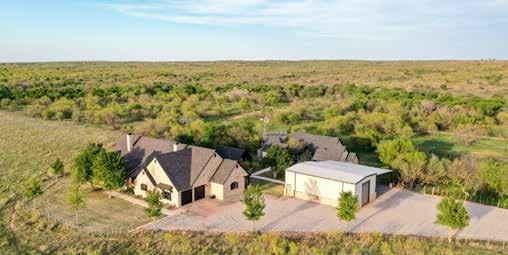
Ritter Creek Ranch
1,940± acres | $5,450,000 | Childress County, Texas
An exceptional turn-key hunting ranch located in a much sought-after area of the Texas Panhandle. The property boasts a beautiful owner’s home, guest quarters, a bunkhouse, and several livestock barns, sheds, and two large shop buildings. Conkline Creek runs north, paralleling the highway on the western portions of the ranch. Several wildlife food plots have been established and there are multiple hunting blinds and wildlife feeders across the ranch. $2,810 per acre.
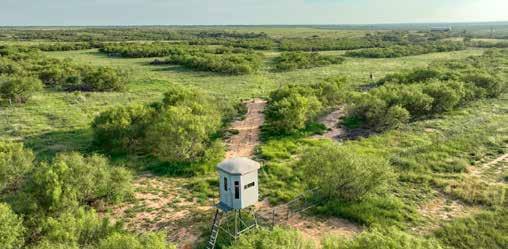
880± acres | $2,950,000 | Paducah, Texas
An outstanding turn-key property that offers exceptional living quarters, a massive shop, outstanding hunting and recreation potential and quality livestock grazing opportunities. Fenced and cross-fenced into six main pastures with traps and holding pens. Beautifully improved with a well-built barndominium, serving as a comfortable residence, garage, and workshop. Abundant populations of whitetail deer, turkey, and quail. $3,352 per acre.

Located just eight miles north of Lampasas, this property lies at the headwaters of Burleson Branch and offers approximately a quarter mile of paved road frontage. The ranch delivers a well-balanced mix of productivity and recreational appeal. To the west of the branch, elevated ridgelines provide prime homesite opportunities with expansive views. Meanwhile, the eastern side features rugged topography, deep draws, and thick woodlands—creating excellent habitat for wildlife and a true sense of seclusion. $8,733 per acre.
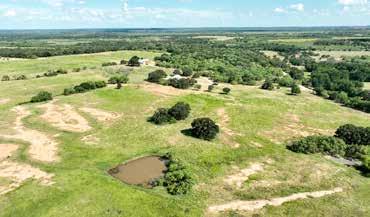
Nestled in the heart of Coleman County, this ranch offers the perfect blend of natural beauty, recreational opportunity, and prime grazing land, making it an ideal property for hunters, weekenders, or ranching enthusiasts. The property offers easy access, coastal bermuda fields, and excellent cover for hunting native wildlife. An exceptional combination of open and rolling meadows, dense canopies, and thickets. A true sportsman’s retreat, Dennis 1 Pasture is home to Whitetail deer, Rio Grande turkey, Feral hogs, as well as dove and quail. $7,000 per acre.

Alamo Canyon Hunting Ranch
2,131± acres | $3,600,000 | Lincoln Co., New Mexico
This is a vast, untamed high desert ranch that elk, mule deer, Aoudad, lion, bear, turkey, quail, fox, and coyotes call home amongst the canyons and craggy ridges. The property is a mosaic of diverse terrains, from rolling hills blanketed in native grasses to rugged canyons carved by ancient waters. The landscape is dotted with junipers and piñon pines. Vast expanses of open land provide breathtaking views of the Sacramento Mountains. Six deer blinds are strategically placed throughout the ranch and offer unparalleled views of the surrounding terrain. $1,690 per acre.
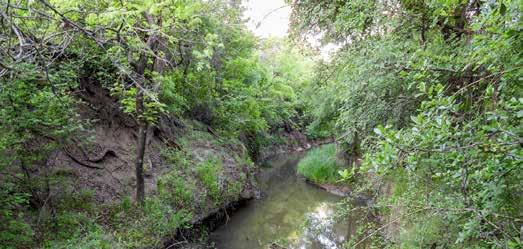
acres |
| Comanche County, Texas
A very scenic property with a highly desirable combination of open grass pastures lined by mature hardwood trees. Chappell Creek flows through the ranch for over a mile, entering the property from the southwest and winding its way northeast. The creek is lined by massive mature pecan, and other hardwoods and conifers. Overall, the ranch offers about a 50/50 blend of open country and dense timbered pasture. There is an abundance of wildlife in this area such as whitetail deer and turkey. $7,435 per acre.

This property features a well-balanced mix of productive wheat farmland and native pasture. It is fully fenced and cross-fenced with fair to good barbed wire fencing. Multiple stock tanks and seasonal creeks provide water sources for both livestock and the native wildlife. Two sets of corrals are located on the property. The area is especially renowned for its excellent whitetail deer hunting. $2,050 per acre.
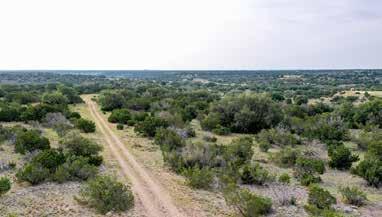
A turnkey hunting property located just 2–3 miles west of Sonora, Texas. Hunting opportunities for whitetail deer, axis deer, turkey, javelina, and dove. Includes three fiberglass hunting blinds along with three All-Season stand-and-fill feeders and three AllSeason hay feeders. Improvements include a mobile home, and a 40-foot storage container divided into sections: one for ATV storage, another for general equipment, and a third that houses a walk-in cooler and a deer processing area. $4,736 per acre.

By Conor Harrison
The annual trip to the deer lease for the start of deer season is a pilgrimage I look forward to yearly. The past several years have been especially fun, since my children have started hunting and look forward to it about as much as I do.
Several seasons ago, my now 16-year-old daughter, Marley, decided she wanted to shoot a deer. Great idea!
Several trips to the rifle range, and Marley was ready with her Ruger rifle.
Anticipation ran high for both of us on a chilly, early November morning. We arrived at the ladder stand well before daylight and got situated. Being still and quiet are not two things that come naturally for a teenage girl, but Marley did a great job remaining mostly quiet as the woods began to wake up around us.
It wasn’t long before a few does came into the setup about 75 yards away and pleasantly munched corn for an hour. It was getting later in the morning, and both of us were getting hungry and beginning to turn our attention toward a breakfast burrito when movement 200 yards to the east caught my attention.
A big-bodied 8-pointer with a rack that was never going to make true trophy status for the other lease members was heading toward the feeder. The buck slowly made its way toward the feeder before making a hard right turn to head into the brush where the does had gone an hour before.
“What was he doing,” Marley asked.
“Trying to find a girlfriend,” I said, “although I don’t think any of them are ready for his advances quite yet. But let me see if I can get his attention again.”
I pulled out the grunt tube from my backpack and let out a series of sharp, loud grunts at his direction.
“Here he comes,” Marley said.
The buck trotted back into the open, stopping broadside as he searched for the source of the grunts. Marley had the .243 ready and I told her to slowly squeeze the trigger. Boom!
The buck immediately dropped, but then got to his feet and ran into the brush. Marley was upset, but I knew it was a good shot. We walked up to her buck several minutes later. The smiles told it all.
I’ve had a lot of great hunting moments, but the high point has been seeing my children on their first hunts. I won’t ever forget that day on the deer lease.

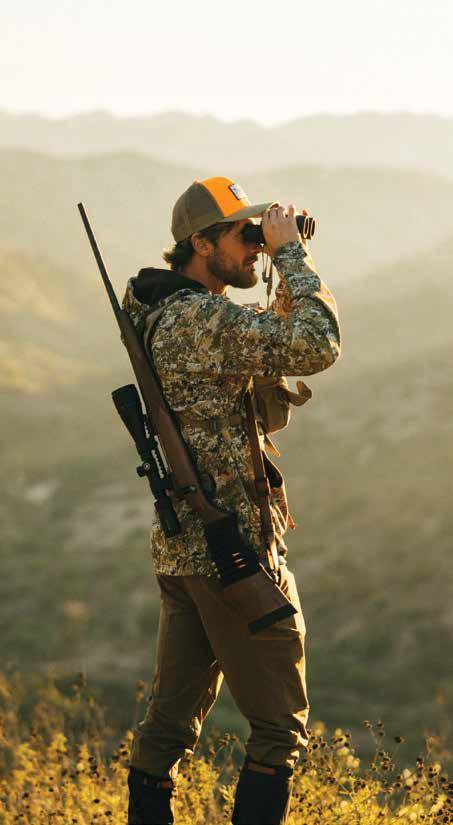





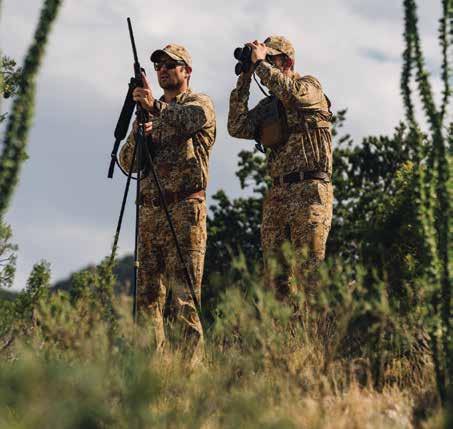



This table provides extra stability for more accurate shots. It also can fold up and out of the way for convenience.
The Precision Shooting Table can be mounted in most hunting blinds — it just needs 42-inch width to mount. It silently slides from left to right to accommodate both right-handed and left-handed shooters.
With a support structure of powdercoated steel, and a durable rubberized top mat for padding and sound-dampening, this table is built to last.
It also adjusts up and down to provide ultimate support for your shooting needs. TexasHunterProducts com

Simply the best deer feeder timer on the market. Easy to operate with a 5-year warranty. Compatible with any six- or 12volt control unit. Can feed up to six times a day. Fuse protected with easy four wire hook up, two to battery, two to motor. Wiring harness is included.
Developed in 2004, it’s reliable, efficient, and durable.
Ask your local dealer for “THE-TIMER.”
“I’ve tried a lot of cheap timers over the years and THE-TIMER is still the best one on the market,” said Mike Hughs of Lone Star Outdoor News.
WestTexasFeederSupply com
Road Armor’s Grille Guard provides the ultimate protection for your truck. The Grille Guard is made in America, using 17-gauge steel uprights, 12-gauge tubing, is factory sensor compatible and utilizes factory OEM tow hooks. With a removable center mesh and four light tabs, the textured satin black power coat will make your truck look great. With a lifetime structural warranty, the Grille Guards are available for Ford, Chevy, GMC, and RAM 1/2-ton and 3/4-ton trucks.
RoadArmor com


Designed for versatility, comfort and rugged performance, whether it’s a camping getaway, a road adventure or a weekend hunting trip, the Freedom Camper delivers the ability to explore.
Weighing only 190 pounds, the Freedom Camper can be easily mounted to or taken out of a truck bed or a utility trailer offering flexibility for a wide range of applications.
Its fully insulated construction makes it a true four-season shelter, keeping users comfortable in everything from summer heat to late season hunting.
The Freedom Camper is more than just a camper – it’s a modular basecamp for the road, the woods or the worksite.
FreedomCampersTexas com

These binoculars deliver high-definition views in a compact, durable design. The Dia mondback HD 10x42 binoculars are built with a phase-corrected roof prism and HD Optical System for excellent resolution, contrast, and color fidelity. Fully multi-coated lenses increase light transmission for a bright image, while ArmorTek coatings protect the lenses from scratches, oil, and dirt. The Diamondback HD 10x42 are built with a lightweight yet durable magnesium chassis and rubber armor for a secure grip. Get a clear image in a lightweight design with the Vortex Diamondback HD 10x42 Binoculars.
“My 10-year-old son, Boone, used these Vortex binocs in Namibia this past summer,” said Conor Harrison, Executive Editor of Lone Star Outdoor News. “They worked great in all conditions and really made his trip enjoyable. We are both huge fans.” VortexOptics com
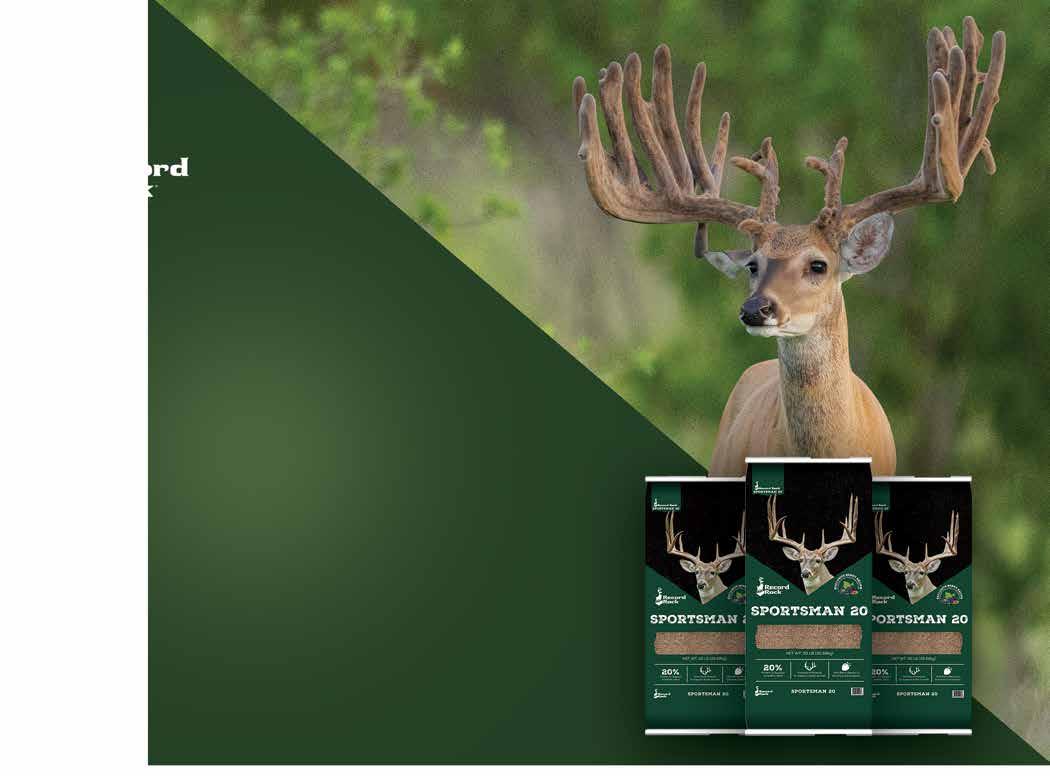

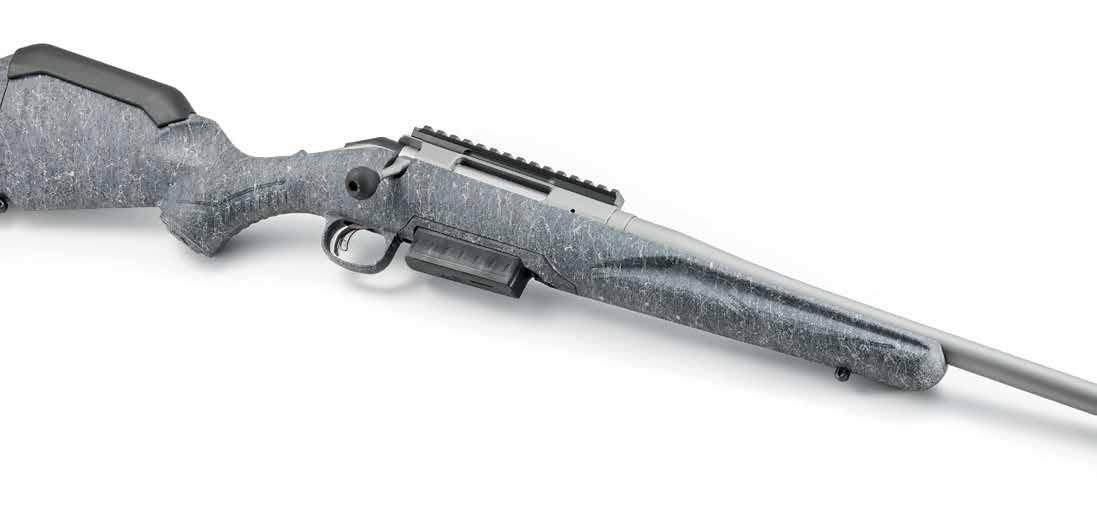


The Ruger American ® Rifle Generation II is an update to the American-made rifle that has been the benchmark for accuracy, durability, and performance in bolt-action rifles for over a decade. Designed with customer feedback in mind, the Ruger American Rifle Generation II is available in a variety of calibers and is sure to become the first choice for hunters and firearms enthusiasts.

The Evoke was built to do one thing: make the hunt easier for people who refuse to settle for anything less than dependable performance. The Academy Edition dresses that intent in Christensen Arms’ Barren Dune camo — a deliberately disruptive, mid-tohigh-contrast pattern that breaks up the rifle’s silhouette across scrub, sand, and windswept flats. Rather than hiding in subtlety, Barren Dune uses defined tonal shifts to obscure shape and edge, keeping you unseen when it matters most.
From the shoulder, the Evoke feels purposeful. Balance, ergonomics, and control are arranged so your mind has one less thing to worry about. The chassis is clean and purposeful; everything on the rifle earns its space. That discipline shows up in the way the Evoke tracks and settles, in the crisp, predictable trigger, and in the bedding that gives shooters repeatable groups. For hunters who rely on muscle memory and sober equipment choices, clarity of design equals confidence in the field.
The Barren Dune finish isn’t just style — it’s operational thinking. Its sharper contrasts break visual continuity at distance while the organic shapes and flat tones prevent flash where light hits close. In open country where game is cautious and wind shifts quick, a pattern that interrupts outline and reduces shine is a force multiplier. Academy hunters who need gear that performs across variable arid terrains will appreciate the practical advantage this camo provides.
Practicality continues at the muzzle. Fitted with a thread protector, the Evoke’s barrel remains protected and field-ready while keeping options open for whatever muzzle device a hunter prefers. Whether you intend to run a suppressor where allowed or prefer a minimal profile for balance and handling, the platform accommodates your choice. It’s about preparedness: the rifle stays serviceable and adaptable without sacrificing the clean lines that help control weight and handling.
This Evoke edition isn’t for the gearhead chasing gimmicks. It’s for the hunter who values repeatable performance, quick follow-up shots, and equipment that behaves under pressure. It’s for the kind of person who measures success in tags filled and stories told at the diner, not in Instagram likes. The Evoke’s restrained aesthetic, combined with purposeful engineering and the disruptive Barren Dune finish, gives you a tool that performs when patience and precision rule the day.
If you’re packing for a season where every decision counts, the Academy Edition Evoke is a practical ally — rugged, refined, and unapologetically effective. It doesn’t call attention to itself; it earns the shot. When the moment comes, that’s all that matters.
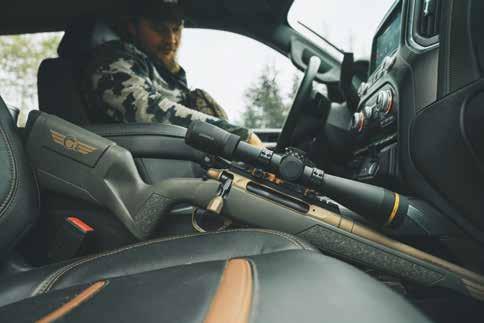
CHRISTENSEN ARMS ☎ (888) 517-8855
CHRISTENSENARMS.COM






By Stephen L Webb
From New York to Texas. From city to brush country. From non-hunter to hunter. That is just part of Edward Tomassetti’s journey that brought him to Texas to study a native big game species.
Tomassetti came to Texas A&M University to study the collared peccary, more commonly known as javelina.
Javelina are classified as a game species in Texas, and found throughout the southwestern United States (Texas, New Mexico, and Arizona). Although they are pig-like in appearance, they are not related to non-native wild pigs.
Despite their classification as a game species, there hasn’t been much research on javelina, leading some to refer to javelina as the Rodney Dangerfield of the game world. Why? Because they just “don’t get no respect.”
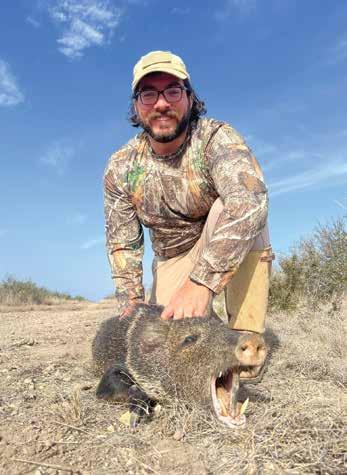
In 2022, the Texas Parks and Wildlife Department put out a call to conduct research on javelina. A group of researchers at Texas A&M University was awarded the project. The project kicked off in late 2023, with the goals of evaluating population survey methods, understanding population dynamics, and determining habitat use and distribution.
Tomassetti was hired to work on the research project as he pursues his doctorate degree. He and several other graduate students have conducted camera and helicopter surveys and capturing javelina to fit them with GPS collars to track their movements.
Upon arriving in Texas, all the talk was hunting. Then, Tomassetti and crew helped collect research data during draw hunts at several wildlife management areas.
“I realized this was the perfect opportunity,” Tomassetti said.
Little did he know, a group of friends and colleagues were about to surprise Tomassetti with his first hunt for javelina.
“They heard my story and used their connections to help put this opportunity together for me. That kind of generosity and support speaks volumes about the hunting community here in Texas,” explained Tomassetti.
Having studied javelina and learned more about their behavior and uniqueness, Tomassetti gained a much greater appreciation and respect for the animal he was about to hunt.
“I had been wanting to hunt for years, and now it was actually happening.” Tomasetti said as he recalled the first morning of the hunt. “That morning was magical. Waking up early, sitting in a blind with a cup of coffee as the sun rose, and watching the world come alive. I’ve seen plenty of sunrises, but this one felt different. I was filled with gratitude for the opportunity, for the people around me, and for the landscape I was immersed in.”
Everything fell into place. The first-time hunter wasn’t just successful at harvesting his first big game animal, but his first harvest was his study species. And if that weren’t enough, he harvested two javelina on his outing, reaching the statewide, annual bag limit.
While still hunting, Tomassetti and his guides approached a squadron (the name for a group of javelina) to within 200 yards. As the javelina crossed an opening, he had a clear shot, so he took it and the javelina went down instantly. It was silent for quite some time. Everyone waited to get the hunter’s reaction. Then, “That was freaking awesome!”
Then the celebration started. Photos were taken. Memories were made. And laughs were had when Tomassetti said: “I think I blacked out. But now that I think about it, my body, my mind, and my concentration were hyper-focused.”
Harvesting a javelina as his first big game animal wasn’t just symbolic, it was personal. Javelina are the reason he’s in Texas doing what he loves — wildlife research.
“They’ve opened doors for me academically and professionally. To have that species be part of such a powerful personal milestone felt like everything came full circle,” he said.
In the end, the hunting community recruited a new hunter. More than likely, a lifelong hunter. His friends, guides, and colleagues made a lasting impression on Tomassetti. Edward experienced everything hunting is about, and that it’s not just about the harvest.
Hopefully, Tomassetti’s hunting experience for javelina will help him conduct meaningful work on the species as he plans to contribute to the management of javelina and their habitat across southern Texas.
“In the future, I hope to be someone who can help others take their first steps into hunting, just like people did for me,” said Tomassetti.




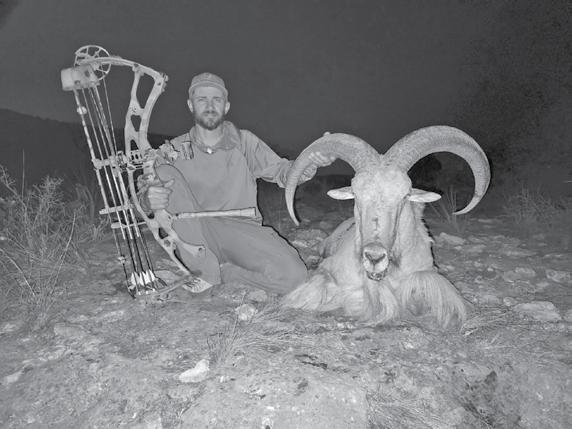
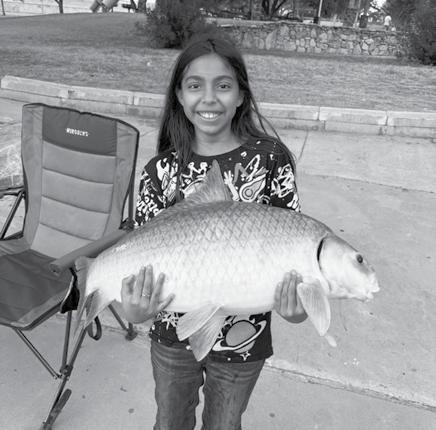
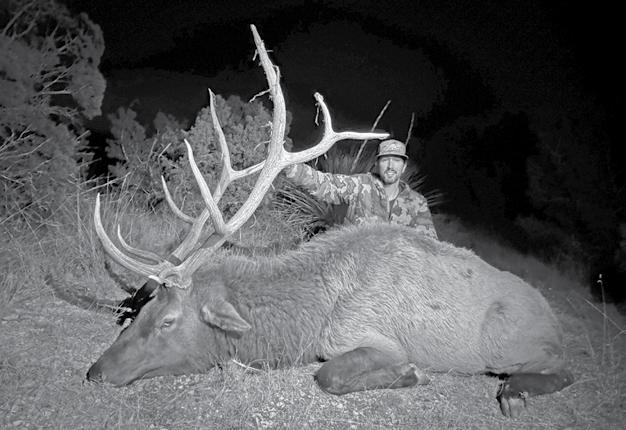


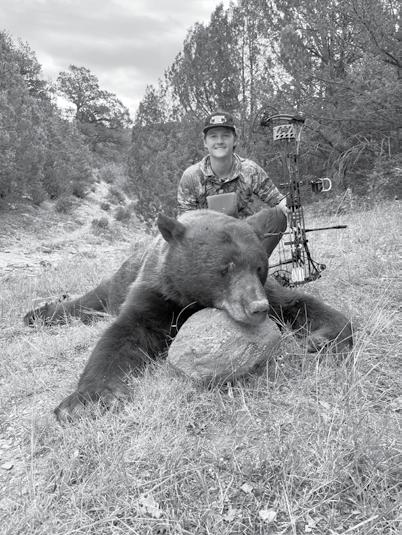




Continued from page 1
that had been falling and other green vegetation in the pasture.”
Johnston said most of the deer activity took place right at dawn or at dusk. He said he assumed the majority of the activity was at night.
Tyler Petoskey also hunted during opening weekend in Schleicher County and reported slow activity, as well.
“The pasture I was hunting in was pretty green, and there were plenty of acorns scattered along the ground,” Petoskey said. “There was also little to no wind during the early morning and late evening hours, which made it tough to get away with drawing a bow from the tree stand I was sitting in.”
Petoskey said he saw quite a few does, but bucks were not frequenting his feeders.
Up in the Panhandle, Shannon Scott spent the opening weekend of archery season hunting in Wheeler County, where she was able to arrow a 16-point buck on the evening of opening day. She said it was the first time she’s ever harvested a buck on the archery opener.
“The buck had been showing up late in the evenings, about three to four times a week on camera at the stand I was hunting,” Scott said. “I had 8 minutes left of legal light after he showed up and finally gave me a shot. The pins on my bow sight were barely glowing, and I knew I had to seize the opportunity.”
Scott said she had not seen a deer all evening from her treestand, when a young spike finally showed up. The spike became alert all of a sudden, and then her target buck walked in from behind her.
“The buck stood directly underneath me for five or six minutes,” Scott said. “He had two other bucks with him, and after what seemed like forever, he finally approached the feeder.”
Scott took her shot, and watched the buck run off into the brush about 50 yards away before he disappeared. She found him expired about 130 yards from the feeder. Scott said the deer scored right at 144 inches.
According to Texas Buck Registry on Instagram, Tyler Chmelar was able to harvest an 11-point buck still in velvet with his bow in Duval County, a couple of days into the archery season. Chmelar said the buck scored 153 inches.
“He showed up on camera the night before the opener,” Chmelar said. “We snuck into the area and hung a stand. A couple of days later he came into the set, and I was lucky enough to put an arrow in him.”
Texas Buck Registry also reported on Instagram that Kasen Kocian harvested a mature buck on the opening day of bow season in Fayette County. The deer was aged at 5.5 years old and sported 14 points.
Bow hunters in Wilson County reported mixed results from the opening weekend of archery season. Some saw bachelor groups of bucks around feeders on properties that didn’t have many acorns falling from the trees. Others reported little to no deer activity around their feeders due to an abundance of acorns hitting the ground.
Continued from page 1
“It’s a little different on Lake Ray Roberts,” Wilson said. “We have been using slabs on them. The problem catching the ones down there is just that there is so much they can eat. There is so much bait in the water there.”
Most of his success has come off lake humps and points in 20- to 25-feet of water. Morning has been the best, more consistent bite.
On Cedar Creek Lake, the fishing has been a little tougher.
“We aren’t doing so much casting as we used to. This summer, to find the white bass, we are trolling,” said Brent Herbeck with Herbecks Lonestar Fishing Guide Service.
Herbeck and his clients have had most of their success targeting main lake humps and points in about 15 feet of water using a Hellbender/Pet Spoon setup between 2 to 3 miles per hour.
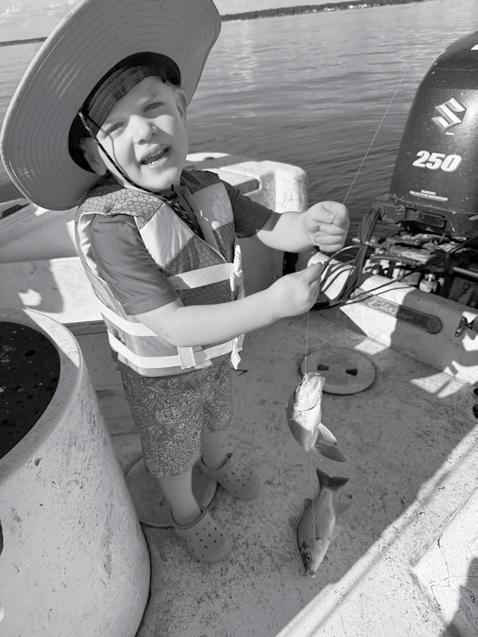


“The fish start slow, and once the sun comes up at 10 a.m. we start catching more fish than at 7 a.m. The warm-up is key to fishing during the day,” Herbeck said. “We are just in a little bit of a transition period right now. As we get into October, it will get a little better.”
On Lake Livingston, the fishing has been great.
“The last couple of cold fronts have really turned on the schooling activity up shallow,” said Mike Richardson with Lake Livingston Adventures. “I would say we are coming from a late summer to early fall pattern right now,.” Early morning has proved to be best for the shallow water bite. As the day goes on, the fish move off to deeper water.
“You have a lot of fry going shallow at night, so that’s why the bite has been good shallow early morning,” Richardson said. He has been transiting to roadbeds in 10- to 14-feet of water after 8 a.m.
“We have been using Ducktracker Slabs with a Texas teaser above it,” Richardson said. Richardson recommends fishing “the day after high pressure comes in that morning. “If you have a little bit of wind, the fishing is good,” Richardson said. The second day after a front is tough. Three days after the front, they will settle back into their normal pattern, he said.


23
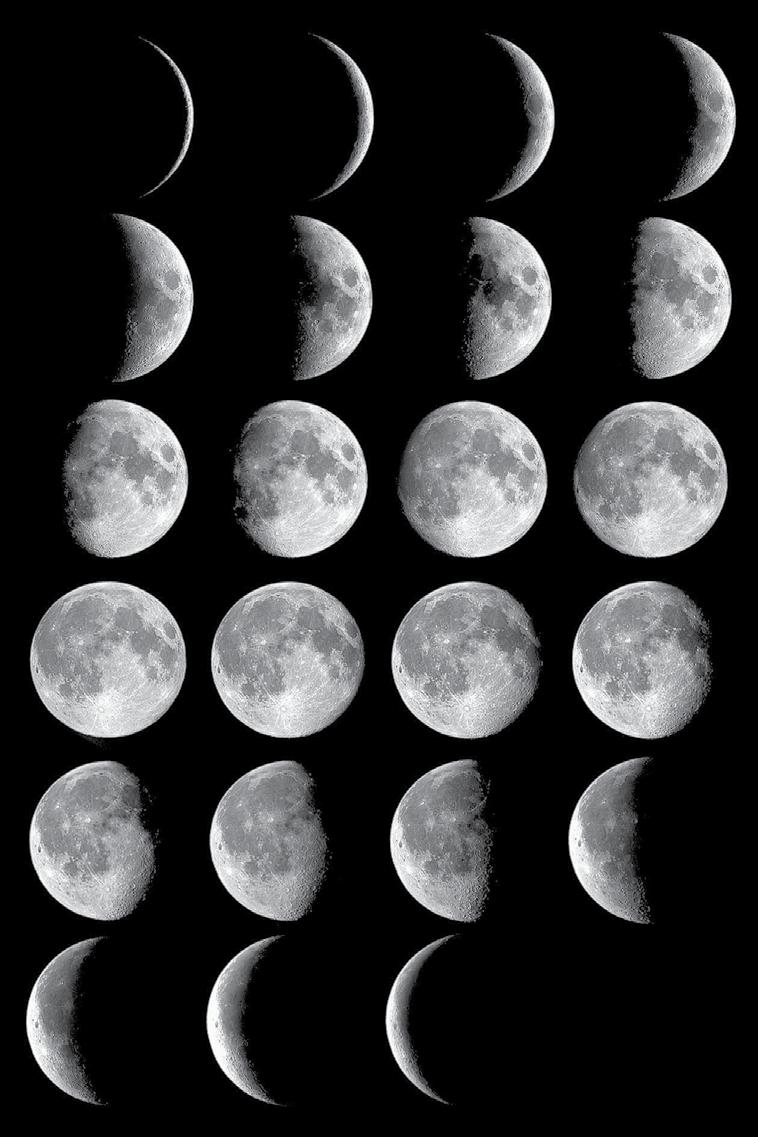



Arkansas’s two-weekend alligator season wrapped up Monday, Oct. 6, and when the last harvested alligator was checked, hunters had tallied 205 alligators, narrowly edging out the previous record of 202 harvested in 2023.
According to AGFC Herpetologist Amanda Bryant, hunters surpassed the initial quota of 204 with one additional harvest. Hunters on public land filled 26 of the 38 drawn public land tags available. The success rate of 68 percent was an improvement over last year’s 58 percent hunter success on public land.
—AGFC
The Arizona Game and Fish Department advises bear hunters to confirm whether annual harvest thresholds have been met in their desired game management units before heading out for nonpermit-tag hunts that open Friday, Oct. 3.
At this time, annual harvest thresholds have already been met in units 1, 2A, 2B, 2C, 3B, 3C, 23 South, and 31, and will not open, even if a hunt is scheduled according to the regulations. The annual harvest thresholds throughout the state are based on female population estimates for the unit. When the number of harvested female bears reaches the annual harvest threshold, that unit will be closed to the additional harvest of bears.
—AZGFD
Last week, Safari Club International filed a legal motion, supported by SCI’s Center for Conservation Law and Education, to intervene in a lawsuit that seeks to nullify Florida’s recently authorized 2025 black bear hunt. The lawsuit, funded by anti-hunters, challenges the Florida Fish and Wildlife Conservation Commission’s August decision to authorize this hunt, the first in a decade.
SCI has long been a vocal advocate for a legal, regulated black bear hunt in Florida. SCI is proud to defend the recommendations of Florida’s wildlife science officials and the interests of the state’s hunters in court against anti-hunters who insist on denying the science of wildlife management and the essential role of hunting in reducing black bear population expansion.
—SCI
The Florida Fish and Wildlife Conservation Commission will begin accepting applications for the 2026 annual limited harvest season of goliath grouper in state waters. Those interested can apply anytime from Oct. 1-15, for the upcoming 2026 season.
This unique recreational opportunity is possible through successful conservation efforts by state and federal agencies over the past three decades that aided goliath grouper population rebuilding. Permits to participate in this limited-entry harvest will be awarded by a random draw lottery. The cost to apply for the lottery is $10 plus fees, and permit lottery applications will be available online at GoOutdoorsFlorida.com.
—FWC
A recent study from the University of Montana, Bureau of Business and Economic Research and Montana Fish, Wildlife & Parks shows that in 2024 more than 450,000 resident and nonresident anglers spent a combined $1.27 billion on fishing trips in Montana.
The BBER study found that cold water fishing (primarily for trout) accounted for most economic activity, which was generated primarily from nonresidents. Cold-water fishing generated about $1.1 billion in trip-related expenditures. More than 70 percent of the cold-water fishing expenditures came from nonresident anglers.
MFWP
Byron Ferguson, 71 of Hartselle was born October 31, 1953 in Lawrence County, Alabama to Clarence Ernie Ferguson and Opal Johnson Ferguson. He passed away Friday, October 3, 2025.
Byron was an internationally renowned longbow archer who traveled the world for 40 years sharing with others what he loved most. He became infatuated with the bow and arrow at the age of 12 and began working as a bricklayer’s helper to earn the money to purchase his first recurve bow. Famous for his coin trick, Byron once shot eight dimes in a row out of the air.
—Staff report
Continued from page 8
hydrilla. There’s also been some fish scattered through hydrilla in 10- to 12-feet of water.” Nixon said that Texas-rigged soft plastics, along with jigs, have been producing the most strikes while targeting bass in the grass. The majority of the fish he’s been catching have been in the 2.5- to 3-pound range. There have been some larger fish mixed in, occasionally.
“You have to cover some water while fishing the hydrilla until you get a bite,” Nixon said. “But once you get bit, you should be able to find 4 or 5 fish in that same general area. And then you just have to keep covering water until you find another stretch of grass holding more bass.”
As far as stripers are concerned, Nixon said most are roaming in depths of 60 to 70 feet over main lake flats in open water. Some are being caught on jigging spoons, as well as on downriggers while trolling.
“The smallmouth bite on Canyon really hasn’t picked back up consistently since the water level rose,” Nixon said. “Hopefully that will change as water temperatures continue to cool off.”
Fishing guide and seasoned bass tournament angler Charles Whited said there is plenty of grass to target throughout the lower two-thirds of Canyon Lake right now.
“The floods back in the summer washed out some of the grass on the upper end near the river, but there’s grass just about everywhere you go further down the lake,” Whited said. “I’ve been finding the most consistent action for bass while flipping soft plastics and jigs in matted grass and grass under the surface in 22- to 25-feet of water.”
Whited said most of the grass out deep in 25 feet of water comes up about 18 feet in the water column. He said the best bite has come from these deeper stretches of grass that you cannot see on the surface.
“Most of the bass have been in the 2- to 4-pound range, but there has been a few 5- to 6-pound fish starting to show as well,” Whited said. “Things are really starting to look good on Canyon Lake.”








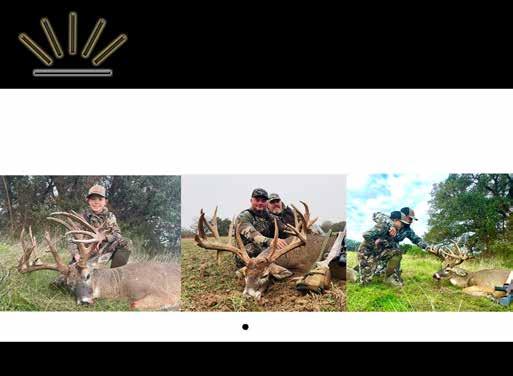

Solution on Page 22

ACROSS
1. Hunter’s cue to stop
3. Pest from Mexico
7. Notch end of arrow
9. Prairie speedster
11. Border river
13. Deer breeding season
16. Young cervid
17. Great fighting fish
18. Hunter’s helper
20. High altitude divider
21. Can’t shoot without these
23. Type of tree stand
24. Female deer
25. Frontier job
26. Traditional aiming aid
28. Bow measurement
31. Group of quail
32. Fast flyer of the woods
33. Known as a mudcat
34. Pintail trophy
35. Large catfish species
36. NE Texas lake
2. Eats longhorns in the swamp 4. Muzzleloader tool 5. NW Texas town
6. Called song dogs for slang 8. Firearm company 10. Javelina name 12. TX mountain range 14. Type of game animal 15. TX border lake 16. Chatty chickens 17. Odiferous critter 19. A buck’s trophy 22. Common exotic in TX 23. Also known as water moccasin
27. Bow shop tool
28. Classic hunting method
29. Invasive marsh rat
30. Duck hunting necessity
Women for Gun Rights officially presented Patriot Mobile with the Business 2A Champion Award during a ceremony in Washington, D.C. This award honors non-firearms industry businesses that demonstrate strong support for the Second Amendment.
Beretta USA announced the return to availability of the legendary Manurhin .357 Magnum revolvers. These elite revolvers are now in stock and ready to ship to dealers nationwide.
The Scholastic Clay Target Program has named Darin Riggleman as programs manager for the Northeast Region.
CenterPoint Archery, makers of crossbows, bows, and arrows, has renewed as a Whitetails Unlimited national sponsor, announced WTU President Jeff Schinkten.
Trijicon, Inc. marks the 40th anniversary of its Bright & Tough Night Sights — the product that launched the tritium night sight category in 1985.
The Congressional Sportsmen’s Foundation announced that Senior Vice President Taylor Schmitz has been awarded the Gary Taylor Award by the Association of Fish and Wildlife Agencies.
SDS Arms announced the addition of Tim Pearce as director of product management.
German Precision Optics announced they have partnered with Joel Harris of Harris Global Marketing & Communications. Harris will be the first point of contact between GPO and the professional media.
2 pounds ground venison
2 pounds Italian sausage
2 eggs
1 1/2 cups ketchup (divided)
1 sleeve saltine crackers, crushed
2 tbs. Worcestershire
2 tbs. Italian seasoning
2 tsps. garlic powder
1 tbs. minced onion
1 tsp. red pepper flakes
Salt and pepper to taste
In a large bowl, combine all ingredients (save 1⁄2 cup of ketchup). With your hands, mix until all ingredients are evenly distributed, and sausage and venison have combined to appear as one ground meat instead of two.


your
Form the meat into a football-shaped loaf and place on a wire rack or roaster inside a larger pan or glass dish. This will prevent the meatloaf from sitting in the juices it releases. Evenly distribute the remaining 1⁄2 cup of ketchup over the meatloaf. Place the meatloaf in a 400-degree oven. A meatloaf of this size should take between 60 and 90 minutes. It’s always best to use a thermometer and pull the meatloaf out of the oven when it reaches 160 degrees in its thickest part. Let the meatloaf rest for about 10 minutes before slicing and serving with your favorite side dishes.
—AGFC
2 pounds flathead
6 c. yellow cornmeal
2 c. Louisiana fish fry (red box)
Salt, pepper, garlic, and cajun seasoning to taste Oil to fry
In a large bowl, mix the cornmeal, fish fry, and seasoning. Cut the flathead belly into 1/2-inch wide strips about 5 inches long. Toss the meat in the bowl, let sit while you heat oil to 350 degrees. Once oil is heated, carefully add your fish, making sure to not over crowd the fryer. Fry about 5 minutes or until crispy and golden brown. Drain on paper towels, repeat until all fish is cooked. Assemble the sandwich by toasting a hoagie, add a layer of fish, topped with coleslaw. Enjoy with fries and hushpuppies.
REDFISH BAY: 87 degrees. Redfish are good on cut mullet and shrimp. Speckled trout are fair on piggy perch and live shrimp. Black drum are good on live or dead shrimp, and Fishbites.
SAN ANTONIO BAY: 85 degrees. Speckled trout are good on soft plastics and live shrimp. Redfish are good on live shrimp and cut mullet.
SABINE LAKE: 85 degrees. Speckled trout are good on live shrimp under a popping cork. Redfish are good on soft plastics, crank baits, and live shrimp. Flounder are fair on soft plastics and live mullet. Sheepshead and black drum are fair on Carolina-rigged live mullet and live shrimp.
BOLIVAR: 84 degrees. Redfish and speckled trout are good on live shrimp and soft plastics. Flounder are fair on live shrimp, live mullet, and soft plastics.
TRINITY BAY: 87 degrees. Speckled trout are fair on soft plastics and live shrimp under a popping cork. Redfish are good on crankbaits, spinnerbaits, soft plastics, and live shrimp. Black drum and sheepshead are fair on live shrimp. Flounder are fair on live shrimp and live mullet.
EAST GALVESTON BAY: 84 degrees. Redfish are good on top-waters, soft plastics, and live shrimp. Flounder are fair on shrimp imitation lures, soft plastics, and live shrimp. Speckled trout are good on live shrimp and soft plastics.
GALVESTON BAY: 86 degrees. Speckled trout and sand trout are good on soft plastics and live shrimp. Black drum are fair on live shrimp. Redfish are good on live shrimp and soft plastics.
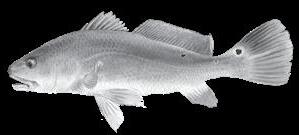
WEST GALVESTON BAY: 84 degrees. Speckled trout and sand trout are good on soft plastics and live shrimp. Black drum are fair on live shrimp. Redfish are good on live shrimp, top-waters, and soft plastics.
TEXAS CITY: 84 degrees. Redfish and speckled trout are good on live or artificial shrimp under a popping cork. Flounder are fair on live shrimp, live mullet, and soft plastics.
FREEPORT: 85 degrees. Speckled trout and redfish are good on live shrimp under a popping
cork. Flounder are fair on live shrimp and live mullet. Mangrove snapper are good on live shrimp. Sheepshead are fair on live shrimp.
EAST MATAGORDA BAY: 85 degrees. Speckled trout are fair on soft plastics, top-waters, and live shrimp. Redfish are good on cut mullet and soft plastics.
WEST MATAGORDA BAY: 85 degrees. Speckled trout are fair on soft plastics, top-waters, and live shrimp. Redfish are good on cut mullet and soft plastics.
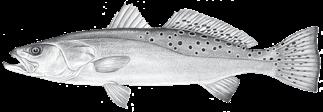
PORT O’CONNOR: 85 degrees. Speckled trout are fair on live croaker. Tarpon and sharks are fair on live croaker. Redfish are good on Spanish sardines. Black drum are fair on dead shrimp.
ROCKPORT: 85 degrees. Speckled trout are good on live shrimp, piggy perch, and croaker. Redfish are good on shrimp, mullet, and piggy perch. Black drum are good on shrimp and Fishbites.
PORT ARANSAS: 85 degrees. Redfish are good on live shrimp, cut mullet, and silver spoons. Oversized redfish are good on cut crab and mullet. Speckled trout are fair on croaker, piggy perch, and shrimp free lined.
CORPUS CHRISTI: 87 degrees. Redfish are good on cut mullet. Black drum are slow. Speckled trout are fair on piggy perch.
BAFFIN BAY: 87 degrees. Speckled trout and redfish are good on top-waters, soft plastics, and suspending twitch baits.
PORT MANSFIELD: 85 degrees. Speckled trout and redfish are good on soft plastics and top-waters.
SOUTH PADRE: 82 degrees. Redfish are good on cut mullet. Black drum are slow. Speckled trout are good on live shrimp under a popping cork. Snook are fair on soft plastics and top-waters. Mangrove snapper are fair on live shrimp.
PORT ISABEL: 82 degrees. Redfish are good on cut mullet. Black drum are slow. Speckled trout are good on live shrimp under a popping cork. Snook are fair on soft plastics and top-waters. Mangrove snapper are fair on live shrimp.
—TPWD

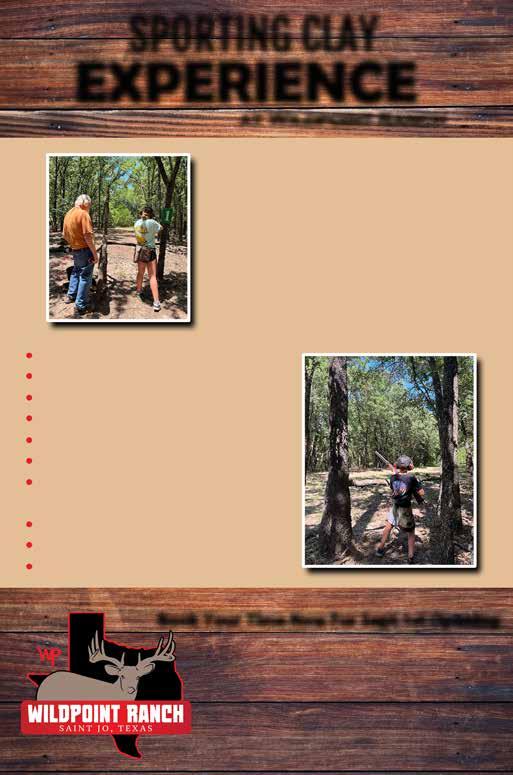



HUNT SOUTH TEXAS
Deer, Hogs, Turkey, Quail, Dove, Javelina, Varmints
350 acres near Freer. Low fence
Fully equipped 3 bed, 2 bath ranch house with satellite TV.
Starting at 150.00 per person per day. Trophy buck, 2,500.00 References. (361) 947-0584
BIOLOGIST 4 HIRE, LLC.
Fish & Wildlife Habitat Consulting, 1-D-1 Wildlife Agriculture Valuation, Conservation Land Assessment & Management Plans, Drone Mapping Services. Chad E. Simmons
USDA NRCS TSP B-19-22936 chad@biologist4hire.com (972) 837-0392
TEXAS TROPHY WHITETAILS Axis, Blackbuck, Hogs Free range whitetail and exotic hunts in Sonora, TX HuntTexasWhitetails.com (717) 512-3582
ADVERTISE YOUR HUNTING
LEASE HERE
Only $1 per word. Email editor@lonestaroutdoornews.com or call (214) 361-2276
AFRICA
Hunting: All Inclusive - No surprises Includes: Animals, daily rates, taxidermy, shipping home. To find out more: LONESTARAFRICA.COM
OCTOBER 11
RURAL REAL ESTATE FOR SALE
Thomas A.C. Davis TDavis@TexasRanchSales.com (832) 977.0071
BANDERA TEXAS DAY HUNTS
Whitetail, Axis, Hogs, Dove (830) 353-2311
MOBILE SPORTING CLAYS FOR HIRE!

Fundraisers, Corporate, Parties! Sales/Service all Traps! 40+ Years Experience! (817) 999-1395
DUVAL COUNTY
South Texas Dove Hunting 200 acres, Lodging, RV Power Available Huntershilton.com For more info (361) 244-0544 OR (361) 443-9330
CATTLE MARKET IS HOT Cash out every Tuesday @10 am Atascosa Livestock Exchange Pleasanton Hauling Available Call (210) 289-7698
COASTAL CONSERVATION ASSOCIATION
Galveston Banquet Galveston Railroad Museum (713) 626-4222 ccatexas.org
DUCKS UNLIMITED

Jaspter DU Dinner Community & Family Historical Society (409) 382-5349 ducks.org

DUCKS UNLIMITED
2025 Lake Ray Roberts Dinner Lone Star Lodge and Marina, Pilot Point (940) 686-0261 ducks.org
OCTOBER 15
QUAIL COALITION
2025 Houston Dinner & Auction The Post Oak Hotel quailcoalition.org
OCTOBER 16
DALLAS SAFARI CLUB
DSC 100 Volunteer Thank You Party Cityplace Event Center, Dallas (972) 980-9800 biggame.org
OCTOBER 17-18
TEXAS TRAPPERS AND FUR HUNTERS Fall Rendezvous Gatesville Civic Center ttfha.com
OCTOBER 17
TEXAS PARKS & WILDLIFE DEPARTMENT
Upland Game Bird Program Fair Park, Childress (806) 452-9828 hailey.hawkins@tpwd.state.gov

OCTOBER 21
DUCKS UNLIMITED
50th Anniversary Texoma Dinner Loy Lake Park, Mayor Arena (903) 820-8882 ducks.org
OCTOBER 24
EXOTIC WILDLIFE ASSOCIATION Conservation Benefit Seasons at the Preserve, Fredericksburg (830) 315-7761 myewa.org
OCTOBER 25
ROCKY MOUNTAIN ELK FOUNDATION
South Texas Region Volunteer Workshop New Braunfels (832) 265-3180 events.rmef.org

DUCKS UNLIMITED Paris/Henry County Sportsmens Dinner Henry County Fairgrounds (713) 234-6395 ducks.org
OCTOBER 31 BUCK FEST Dinner and Dance Mansfield Park Show Barn, Bandera (830) 796-3280 banderachamber.com
NOVEMBER 13
DALLAS SAFARI CLUB
Speaker Series Event Royal Oaks Country Club (972) 980-9800 biggame.org

FOR SALE - 270 AC HUNTING RANCH near Red Oak, OK. 3/4 mi. of Brazile Creek, food plots, abundant wildlife. JC Barr, Broker jcbarrauctions.com


RIO GRANDE PIPE/ RENO EQUIPMENT Our companies specialize in High Quality,clean, easily paintable, structural tubulars for fencing and construction from 1” to 36”. We have heavy weight and thick wall pipe in a variety of sizes, pre-cut posts, posts cut-toorder, and rods. Some other items we stock are 8400 gallon steel storage tanks (12’ wide x 7’ tall), pre-built H-braces, fence crossing ladder/ stairs, and culverts. Contact Josh Brown at (505)-366-3428, or Cody Hudson at (575)-441-1186

TEXANS ARCHERY CLUB Network of Archery Ranges For One Membership! TEXASARCHERY.INFO
HUNTING LEASE AVAILABLE Rocksprings, TX 3 Blinds and Feeders Cabin for 3 people (612) 723-1323

For home or office delivery, go to LSONews.com, or call (214) 361-2276, or send a check or money order to the address below. Lone Star Outdoor News, ISSN 2162-8300, a publication of Lone Star Outdoor News, LLC, publishes twice a month. A mailed subscription is $35 for 24 issues. Newsstand copies are $3, in certain markets copies are free, one per person. Copyright 2025 with all rights reserved. Reproduction and/ or use of any photographic or written material without written permission by the publisher is prohibited. Subscribers may send address changes to: Lone Star Outdoor News, P.O. Box 551695, Dallas, TX 75355 or email them to editor@lonestaroutdoornews.com.
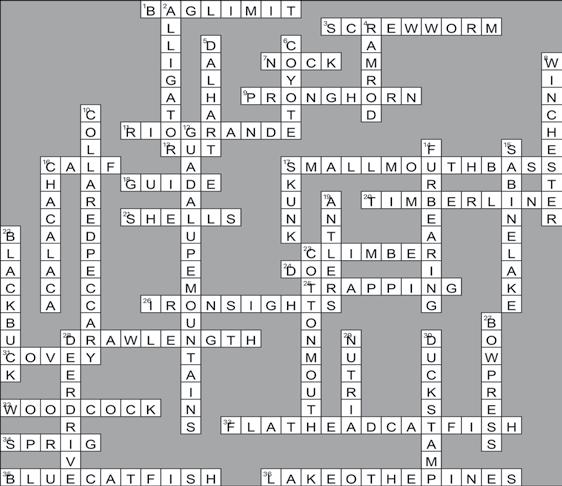



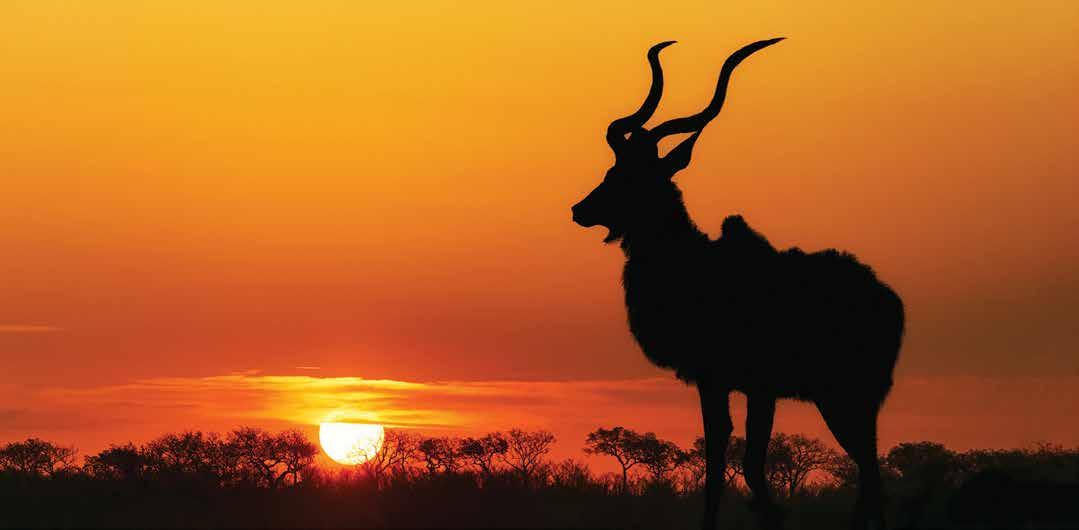

Experience one of the largest hunting, fishing and outdoors events in the U.S. Start things off with our Conservation Kickoff Banquet & Auction on Thursday, then continue the fun at this massive, 3-day expo featuring top outfitters, gear manufacturers and conservation partners – plus banquets, auctions and special events, like the Conservation Champions Breakfast and the Ladies Luncheon & Auction. Bring the whole family, 1-Day passes start at just $35 and kids (16 and under) are FREE! Register now to be a part of the future of hunting and conservation.